
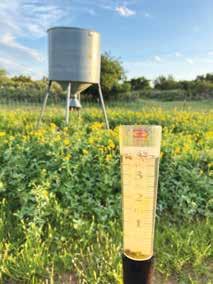







By Nate Skinner For Lone Star outdoor newS
Recent rains and precipitation events have caused various types of vegetation and warm season forbs to explode across the landscape. Blaise Korzekwa, Texas Parks and Wildlife Department’s Whitetailed Deer Program leader,
By Nate Skinner For Lone Star outdoor newS
Heavy thunderstorms earlier this month brought flooding rains and tremendous runoff to estuaries, particularly from Palacios up to Sabine Lake.
Some areas received 10 inches of rain or more, and rivers, bayous, and creeks inundated the upper reaches of bays and marshes with freshwater. Anglers were met with off-colored water and were forced to adjust their game plans.
Ryan Welch spent time in some back lakes and marshes off the Intracoastal Waterway in the Freeport area, just southwest of Bastrop Bayou, where he said a strong incoming tide kept the freshwater
runoff from dispersing.
“Freshwater was flowing hard out of bayous, creeks and marsh drains, but the tide was rushing in,” Welch said. “This made for less-than-ideal water clarity in a lot of places, be cause the runoff couldn’t spread out across the bay.”
Welch said the marsh ponds and back lakes he targeted were full of baitfish and small shrimp.
“The water was really dirty, but the runoff had pushed a ton of shrimp out of the back reaches of the marshes, and schools of speck led trout were feeding on them,”
Welch said. “There were groups of seagulls working over schools of trout just about everywhere I went.”
Welch said most of the trout
Please turn to page 18

said this will have positive impacts on both fawn crops and antler growth.
“Portions of the Hill Country, South Texas, the Post Oak Savannah region, and the majority of the Edwards Plateau region have been plagued with drought conditions,” Korzekwa said “Although the recent rains that
we have received did not end the drought in most of these areas, they still occurred at a crucial time to help our fawn crops and improve antler growth for bucks.”
Korzekwa said the Piney Woods, Blackland Prairies, Cross Timbers, and Rolling Plains regions are in good shape in terms of range con-
ditions and precipitation. He expects those areas to have above average fawn production this year.
“The remainder of the state should see average fawn production and survival rates this summer,” he said. “There are plenty of fawns already on the ground in the eastern third of the state, and there will be

By Cory Byrnes For Lone Star outdoor newS
Summer is officially here, and that means the bluegill are spawning in many lakes and rivers.
The best thing about bluegill is that everyone has access to them. In the Mansfield area.
James Welday has been fishing the neighborhood ponds, us-
ing a simple red worm on a slip cork.
“We catch a lot on a trout magnet as well,” Welday said.
Neighborhood ponds that are stocked with bluegill generally lack structure. Welday targets medium shallow water from 3 to 5 feet.
“They are starting to bed down,” he said. “I typically am looking for pockets or where the
pond bends. You’re looking for water deep enough to fish but shallow enough the bigger bass don’t want to be there.”
Once we reach July, the bluegill move deeper.
“That’s when you will have to go low-and-slow to find them,” Welday said.
In the Salado area, Josh Wells primarily fly-fishes for bluegill with 3 or 5 weight rods.

WHATEVER YOUR ADVENTURE IS, WE'VE GOT YOU COVERED.


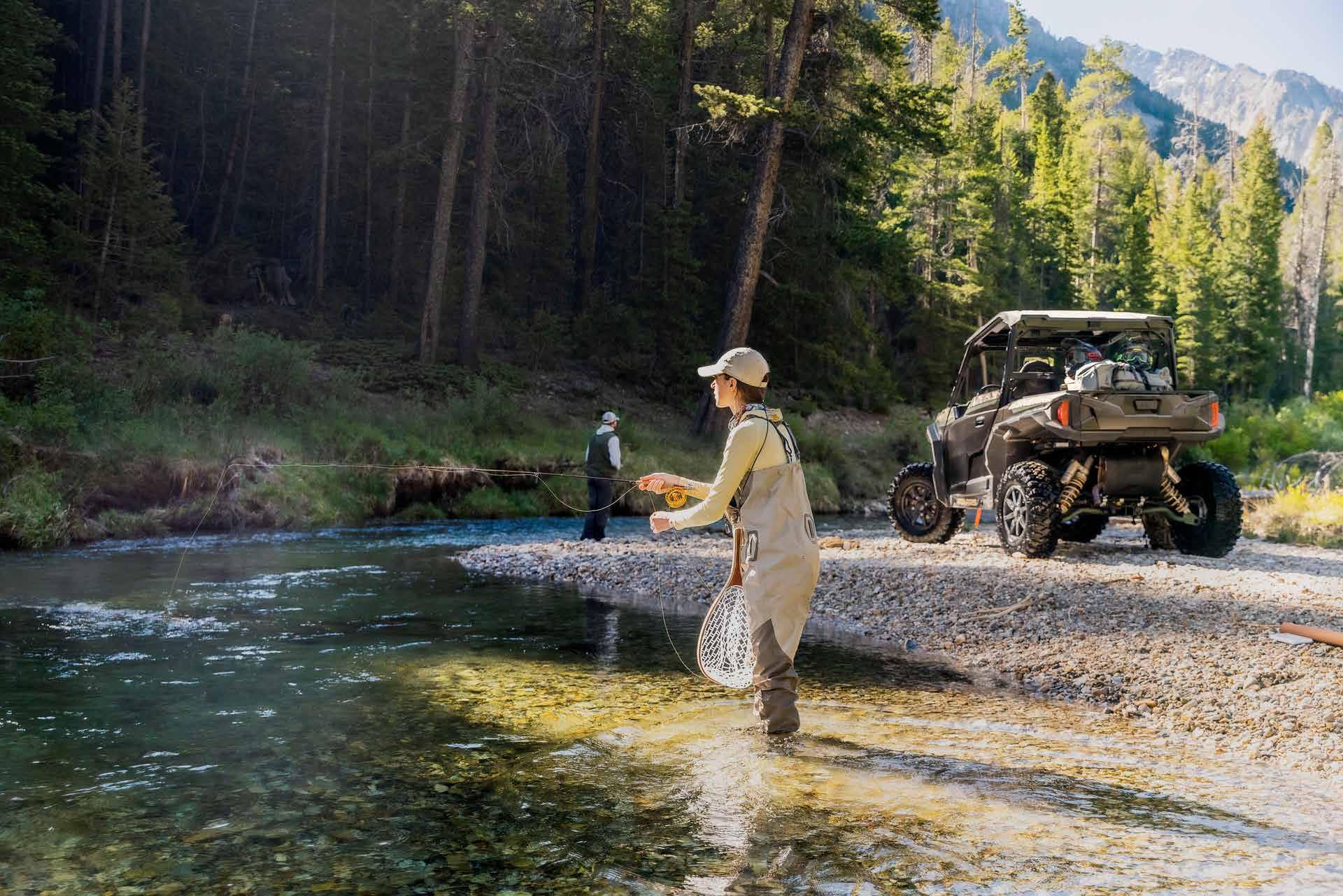



By Miguel Morales For Lone Star outdoor newS
This time of year, especially paired with good rainfall, there is new life everywhere from the greenery to the fawns, turkey poults, quail chicks and the bugs they feed on.
Rainfall provides cover and insects for the new poults and chicks to feed on. This has led to significant growth in forage and can make it hard for newly hatched chicks to forage for insects. The first two weeks after hatching their diet is composed
The 2025 Texas Dove Hunters Association Sporting Clay shoot brought together members, fellow dove hunters and friends as part of the more than 100 shooters.
The overall winning team was a family affair, with Walter Priestly shooting a 97, 13-year-old son Luke shooting 98, and 9-year-old son Myles shooting 86. Paul Dirks rounded out the total score of 375 with his total of 94.
The event included a 100-shot sporting clays round, meals, an auction and raffles. The event supported TDHA’s Flight Youth Program, which includes scholarships, Dove 101 curriculum and Youth Days.
The High Overall Award went to Jar ed Musgrove, who shot 98, tying Luke Priestly and Art Rivera but winning in a tiebreaker.
Bailey Glenewinkel won the Lady High Overall Award with an impressive 96, and Myles Priestly won the Youth High Over all.

of purely insects, as the protein promotes their feather growth. Hens will predetermine where they take their chicks first before they even leave the nest. The favored brooding ground is fairly open, ground level, with cover nearby.
Dale Moehlmann has observed several hens with poults over the past two weeks in Atascosa County.
The first group was seen June 11 and looked like they had just left the nest. This past week he saw four hens in three different locations with slightly bigger poults.
Atascosa County has received 12.89 inches of rainfall so far this year (4.91 in June), compared with 14.55 total inches last year and 16.01 the year before.
“This past week we’ve been shredding not only our roads but our roller-chopped strips we have for our quail,” Moehlmann said. “Shredding these strips with the shredder almost all the way down provides a great brooding location for both poults and quail chicks. They have the open area of the shredded strip, right by low-lying grass and
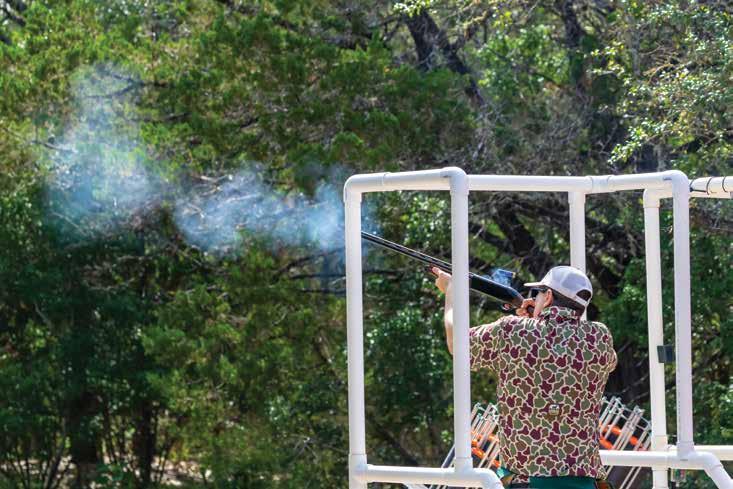
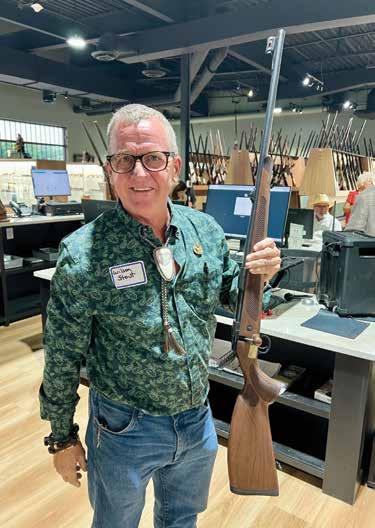
Dallas Safari Club and Outdoors Tomorrow Foundation hosted an invitation-only event June 19 at the new Collectors Firearms store in Dallas to celebrate the future of our hunting heritage.
“Engaging our youth is critical to the future of our hunting heritage and no one does it better than our good friends at Outdoors Tomorrow Foundation,” said Rob McCanna, DSC chief executive officer.
Wilson Stout announced he would be donating $10,000 at the event, and other significant donations followed. After appetizers and drinks, a door prize, with numbered tickets given as people entered the store, was drawn at the end of the celebration.
Collectors Firearms had donated a CZ Safari rifle as the prize, and karma won out. The ticket drawn belonged to Stout.
The Wild Sheep Foundation has placed a moratorium on promoting or selling aoudad hunts at its Sheep Show and local banquets.
“Conservation of native wild sheep and the ecosystems they occupy comprise the primary mission of the Wild Sheep Foundation,” WSF said in a release. “WSF supports scientific solutions to resource management challenges, and to that end, WSF has invested heavily in research related to disease investigations and mitigation, wild sheep populations and habitat management, control of non-native wildlife, and other strategies.”
WSF said it recognizes the value of some exotic species to hunters, state wildlife agencies, and landowners; however, any endeavor counter to the WSF mission should be avoided.
Recent scientific research shows that aoudad have adversely impacted both desert bighorn sheep populations and the habitat in which they live. In Texas alone, aoudad have reduced the native desert bighorn sheep populations by over 75 percent, with numbers continuing to decline. These declines are the result of pathogen transmission from aoudad to desert bighorns, impacts to social structure of native bighorn sheep herds, and degradation of habitat.
The Wild Sheep Foundation finds the promotion of aoudad hunting in direct opposition to its purpose of “Putting and Keeping Wild Sheep on the Mountain.” Effective immediately, WSF has implemented a moratorium on all sales, support, promotion, or advertising of any aoudad
By Craig Nyhus Lone Star outdoor newS
U.S. Department of Agriculture Secretary Brooke Rollins traveled to Edinburg to announce plans to reopen Hidalgo County’s Moore Air Base and a New World screwworm (NWS) sterile fly dispersal facility.
The announcement was a part of the larger NWS Domestic Readiness Policy Initiative, which outlined current and future efforts to keep the flies at bay and protect livestock and wildlife.
At the base, the long-term production is anticipated to be 300 million sterile flies per week.
Last month, Sec. Rollins pledged to invest $21 million to renovate a fruit fly production facility in Mexico to produce sterile NWS flies for distribution.
“The United States has defeated NWS before and we will do it again,” Rollins said.
The key facets of the initiative include:
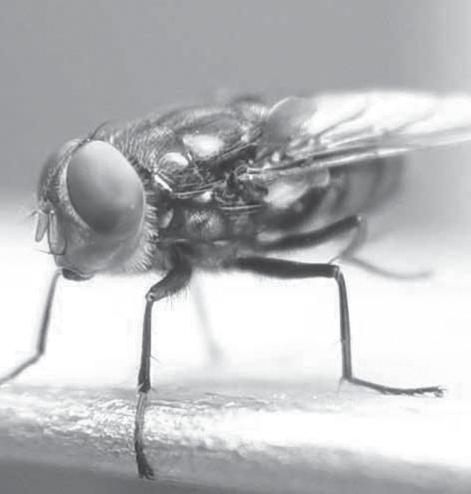
1. Stop the pest from spreading in Mexico and ensure we are full partners in eradication
2. Protect the U.S. Border at all costs
3. Maximize our readiness
4. Take the fight to the screwworm
5. Innovate our way to eradication
Also, good news for wildlife managers, Rollins said USDA is exploring all options to eradicate NWS, which includes potential expenditures in new technologies and new science. USDA will hold four public listening sessions to get feedback on eradication tools and technologies aside from sterile fly production, the benefits and barriers including timelines and costs of enhanced domestic versus international sterile fly production, and other innovative ideas.





The first-of-its-kind Game Fair held in Texas, The Texas Hill Country Game Fair, took place June 20-21 at Joshua Creek Ranch, in Boerne, with the goal of getting people, including outdoor sporting enthusiasts, conservationists and supporters of youth education to the ranch and to the outdoors, along with some unique and interesting features.

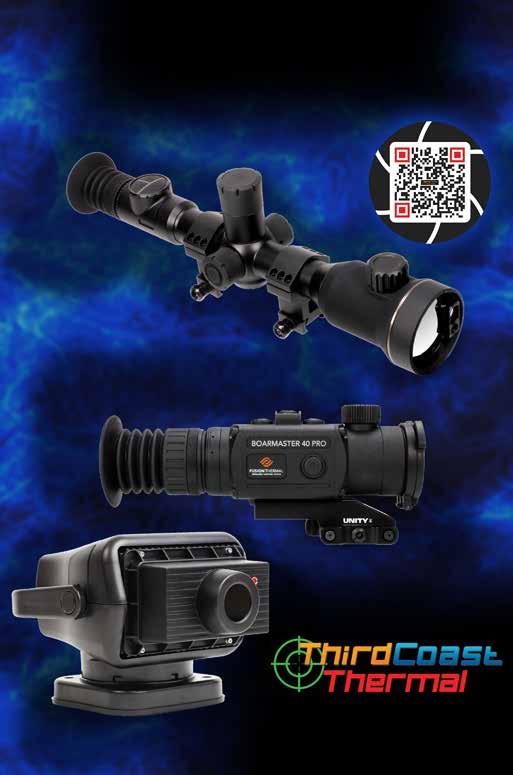

With vendors, auctions and other activities to help raise funds, “the conservation and youth education programs that benefit from this unique event will positively impact efforts to preserve and protect wildlife and natural resources while making a difference in the lives of young people,” organizers said.
The Game Fair and unique shooting format was the brainchild of event organizers, the San Antonio Stock Show and Rodeo’s Wildlife Committee, chaired by Duane Westerman and made up of about 100 members, with approximately 35 volunteering at the event.
The event began Friday with a Helice shoot and a dinner and auction.
One vendor said Saturday crowds were light and after a brief shower followed by a cool breeze made things comfortable.
“The creekside setting was real nice under the cypress trees,” the vendor said.
There were about 50 vendors on site, including outfitters and outdoor brands like Record Rack, Duck Camp, Orvis, Caesar Guerini, and Fausti and Rizzini shotguns.
In the Wingshooting Challenge, which simulated field-hunting situations, at each station six clays were thrown, but one was an “illegal bird” target.
For example, at the Dove Station, the instructions were “Don’t shoot the Inca dove.” A smaller target was thrown, and if the shooter fired and hit it, a deduction was given.
At the Rabbit Station, instruction were, “Don’t shoot the dog,” and one of the targets thrown had features distinguishing it. At the Duck Station, instructions were that the landowner didn’t want greenheads shot. One of the targets was green.
Each of the 15 four-person teams moved through the stations quickly, with a goal of a 5-7-minute turnaround.
The winning team, the Federal Premium Ammunition team, consisted of Daniel Deeb, CEO Jason Vanderbrink, John Brooks and Blythe Brooks. Each took home big belt buckles for the win.
Continued from page 1
more hitting the ground farther west and south over the next month.”
Korzekwa said the increased vegetation will provide fawns with additional cover for shelter during the heat of the summer.
“After they are born, fawns will follow does around, but ultimately they will pick where they bed down,” he explained. “With increased vegetation and cover across the landscape, fawns now have more options to choose from. This typically leads to higher fawn survival rates.”
Daytime temperatures have also been more mild immediately after the passing of recent rain events. This delayed heat wave also works in favor of fawn crops.
“The longer our fawns can avoid extreme heat, the better,” Korzekwa said.
“They are most susceptible to harsh conditions right after they are born. The more they are allowed to grow before extreme heat sets in, the higher their chances of
survival.”
Korzekwa said the increase of summertime forbs and grasses across the state did take place early enough to have some positive impacts on antler growth and production as well.
“Rainfall during the months of March, April, May, and June is what is most crucial for antler growth,” he said. “So, recent rains have still been timely enough for us to see the benefits this coming fall.”
With does having to meet the demands of lactation right now, Korzekwa said the increase of forbs and other vegetation has also provided them with additional sources for nutrients and calories.
“Although these summertime forbs and grasses cannot completely offset the demands of lactation, they definitely help does make it through this crucial fawning season,” he said.

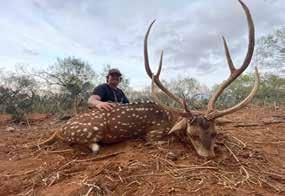
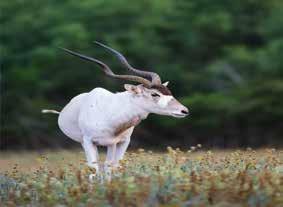


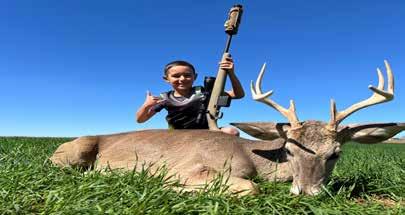




By Tony Vindell
For Lone Star
Two groups of Texans made the trip to Cabo San Lucas, Mexico, to fish in the deep waters of the Pacific Ocean off the Baja Peninsula.
After a couple of excursions, the longest of which was only about 20 miles offshore, the anglers ended up bringing in a menagerie of fish species, including wahoo, dorado and yellowfin tuna.
For Jared Maness, an avid hunter from McDade, and the nine others in his group, fishing was as good as anyone can ask for. There were four members of the Maness family that made the trip, along with six others from LaGrange.
On the first day, they all caught about a half-dozen tuna while the other group, from the Rio Grande Valley, netted 12 of the fastswimming fish.
Day two was a different story as the weather, the swells and the fishing completely changed.
“We caught 23 tuna on the second day,” Maness said. “We also caught a 65-pound wahoo.”
The group hooked a couple of blue marlin but could not bring them close to the boat for the typical picture before the fish is released. In the other boat, the RGV anglers hooked three blue marlin but the fish eventually won each battle.
In the end, the Central Texas anglers took home nearly 50 pounds of frozen fish fillets, while the six RGV anglers each brought home about 25 pounds of tuna fillets.
Unlike some food items, fish is a commodity that can be brought back from Mexico, and a company in Cabo San Lucas will freeze and vacuum pack them for the trip home, or fishermen can freeze them and check them as luggage — but keep in mind the weight restriction on luggage of 50 pounds, or you’ll pay extra.
The two groups made the trips after outbidding others during live auctions held at Coastal Conservation Association banquets. One was held in Bastrop last July, and the other took place in Port Isabel.
The trip to Cabo, donated by Karma Sports Fishing, included two days of fishing and four days in a condo complex some 15 to 20 minutes from the marina. The packages included breakfast, lunch, water and some Mexican brews on board.
By Meghan Jackson For Lone Star outdoor newS
Some of the best art is inspired by the beauty of the outdoors — and there is a father/daughter duo that perfect it as artists.
With three World Titles, Phil Brannan is a wood carver specializing in realistic fish sculptures. With great success, he has created a family legacy that his daughter, Sunni Gonzales, is keeping alive.
“Both of my parents encouraged and taught me many things growing up as they both shared a love for art,” Gonzales said. “From screen printing T-shirts, web design, you name it — I’ve done it and pursue art as a career now.”
Gonzales said her father is quite familiar with Lake Fork Marina and knows all of the guides and people there. Through mutual connections, they were assigned to create a fishing mural at Jamie’s Restaurant.
“Painting murals has been my focus lately as I work with Walmart to create them for stores being renovated,” Gonzales said. “I am currently working on a Brownsville Walmart and Sam’s Club, in Keller, but with this project with my dad, this was only my second or third one I have done outside.”
The daughter and father planned thoroughly, created sketches on an iPad, and made sure everything was perfect. She said her father fully understands the anatomy of the bass and with her skill of painting on a flat wall, they were unstoppable.
“We both used our strengths to collaborate and of course it was meaningful because I was
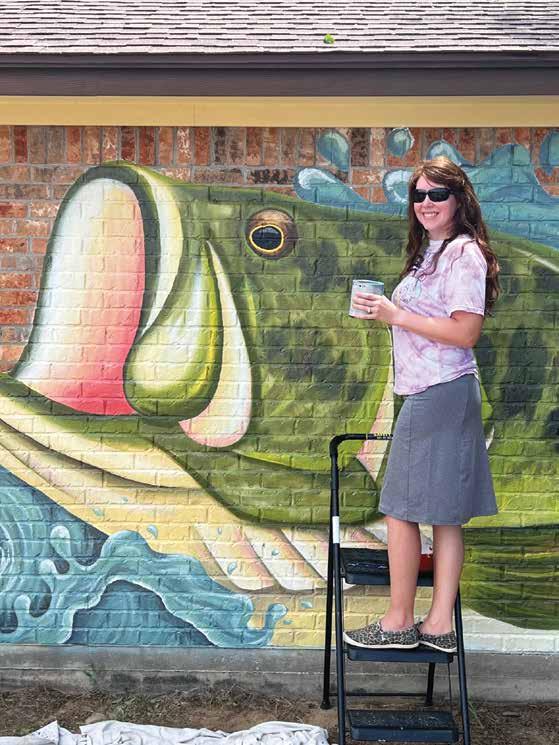
doing it with my dad,” Gonzales said. “We had never worked on a project like this together and for him to have his stamp

on that town was super special.”
Brannan’s art is usually done on a smaller scale, and Gonza-
By Nate Skinner For Lone Star outdoor newS
Summer is here, and anglers are finding largemouth bass in both shallow and deep water, as the fish have settled into their warm-weather patterns.
Plenty of fish in the 1-3-pound range are being caught on numerous lakes, and some larger bass have been providing exciting moments for some.
Laney Welch was crappie fishing recently with her dad and grandfather on Bois d’Arc Lake, and caught a 7-pound largemouth.
“I was fishing with a live minnow over a brush pile in about 15 feet of water, when I hooked into something that almost bent the ultralight rod in
les said this experience consisted of experimenting with their art skills. The goal was to create a detailed bass mural to
half,” Welch said. “My line ended up breaking, so I switched to a little bit heavier set-up.”
Welch dropped another minnow back down, and ended up hooking into another large fish. After running around the boat a few times, the fish finally wore out and she was able to land the 7-pounder.
On Caddo Lake, guide Randy Deaver said the largemouth bass are staging in the grass in anywhere from 1.5-3 feet of water.
“There are also quite a few fish concentrating around trees in about 5 feet of water,” Deaver said. “Pretty much any stretch of water with lily pads, grass and aquatic vegetation from 1.5 to 5 feet of water can be productive.”
Top-waters, frogs, and a variety of
By Nate Skinner
For Lone Star outdoor newS
As the owner of KDEN Lures, avid redfish tournament angler Jacob Sumney spent two years perfecting a soft plastic lure he considers to be his number one confidence bait.
The lure is called the 365 Shad, and the 3.5-inch paddletail soft bait has quickly earned the reputation as a swimbait that all levels of anglers can confidently throw in a variety of scenarios.
“As anglers, we are always searching for that particular bait or lure that we can feel good about having tied to the end of our line, even when the conditions are brutal,” Sumney said. “You might try something new that someone else recommends from time to time, but there’s always that one bait that you go back to when nothing else seems to produce a bite. That’s exactly what I set out to create with the 365 Shad.”
Sumney said the process of creating this bait included 11 sample mold variations before he finally settled on one.
“I spent countless hours testing bait samples in my buddy’s swimming pool, and observing how they moved through the water,” he explained. “I also provided samples to a handful of veteran tournament anglers and fishing guides that were willing to help me and provide their insight on how I could make the lure better. Other people I knew and respected that had produced their own line of lures also provided me with their insight and knowledge. The 365 Shad wouldn’t have come to fruition without these folks.”
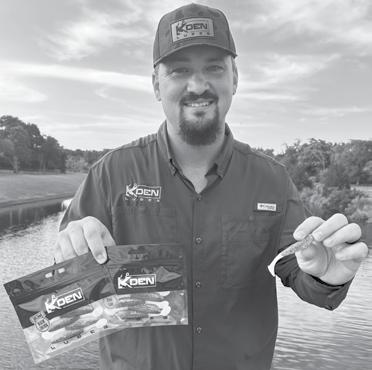
Many seasoned tournament anglers and fishing guides are achieving success and cashing checks in tournaments with the 365 Shad.
“There’s nothing better than seeing someone have success on a lure that I poured my blood, sweat and tears into,” Sumney said. “Every time someone tells me that they love the baits and are catching fish with them, it brings me joy.”
In addition to the 365 Shad, KDEN Lures currently has two other models in their lineup of baits — the 4-inch Blazin’ Shad and the 5-inch Magnum Shad. Sumney took over ownership of KDEN Lures in 2020. He had been fishing with the company’s lures and promoting them for about 2 years.
Please turn to page 12
Making a mark in reel repair
By Meghan Jackson
For Lone Star outdoor newS
Southwestern Parts & Service has officially moved locations from Dallas to Grapevine. With 40 years of making a positive impact in the fishing world, their new location will continue to keep their same tradition.
Owner Shane Moore reflected on the journey of the family business and said he is excited for this new chapter.
“We are trying to devel-
op a larger customer base and I think this is a great area to do so,” Moore said.
“There are many fishermen in this area, and we want it to be convenient for people to get to us.”
This business was started by Moore’s father back in the 1970s based on the family’s love for fishing and the outdoors. Moore said when he was only 11 years old, his dad put him on a repair bench and he learned how to fix and repair reels.
“The evolution of fishing over the years is evident in our company’s history,” Moore said. “We
Please turn to page 18



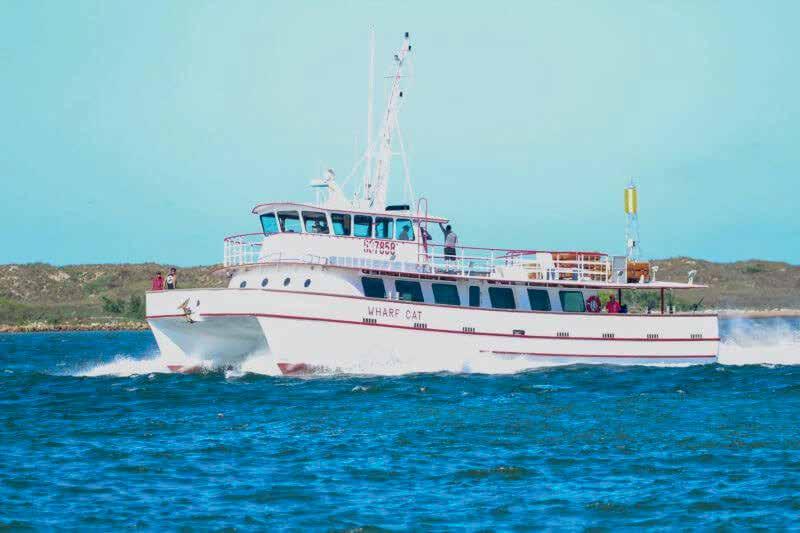
The Texas Freshwater Fisheries Center will welcome the public back July 1 for its grand reopening following major renovations.
Renovations commenced in August 2023, updating nearly 300,000 gallons of aquariums, adding new large aquariums, renovating the Toyota Fishes of Texas theater and other existing exhibits and adding new exhibits. The project also enhanced recreational fishing ponds, like Lake Zebco and Strike King Pond. Texas Parks and Wildlife Foundation and the Friends of TFFC provided $8.5 million in funding for the project.
“TFFC has always been such a wonderful place for Texans and people across the country to connect to the fish, fishing and fisheries resources of Texas while learning of the important work the men and women of the TPWD Inland Fisheries Division conduct to conserve and manage these resources,” said Tom Lang, TFFC Director. “With this renewal of TFFC’s facilities, fishing ponds and piers, equipment, exhibits and educational programming, we again have a first-class facility to support the fisheries conservation journey of visitors for decades to come.”
The July 1 re-opening kicks off with a ribbon cutting ceremony with the Athens Chamber of Commerce and activities culminate July 6 with the annual City of Athens Independence Day event “Fireworks at the Fisheries,” a Fireworks display over the hatchery ponds.
Admission for adults is $5.50 with spring and summer hours of operation through August with opening times from 9 a.m.–4 p.m. Tuesday through Saturday and 1 p.m.–4 p.m. on Sunday. From September through February, the facility closes on Tuesdays.
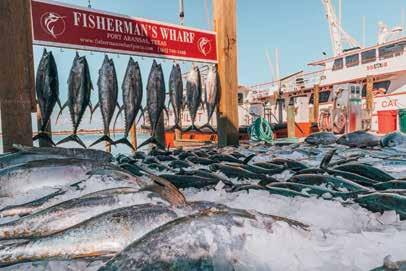


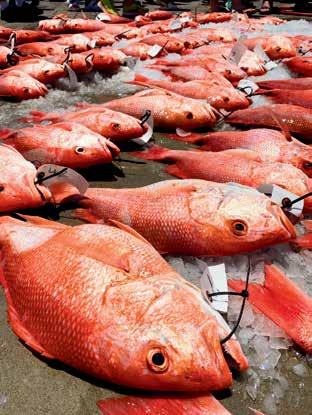
ALAN HENRY: Water clear; 76 degrees; 0.67’ low. Crappie are fair on jigs and minnows.
AMISTAD: Water stained; 82 degrees; 68.09’ low. White bass are good on slabs. Catfish are good on punch bait.
ARLINGTON: Water stained; 80 degrees; 0.71’ high. Largemouth bass are fair on soft plastics and crankbaits.
ARROWHEAD: Water stained; 80 degrees; 0.08’ low. Catfish are fair on punch bait.
ATHENS: Water stained; 80 degrees; 0.97’ high. Largemouth bass are good on Texas-rigged worms, wackyrigged senkos and crankbaits. Crappie are slow.
AUSTIN: Water stained; 80 degrees; 0.51’ low. Largemouth bass are fair on swimbaits, drop shots, Texas rigs and shaky heads.
BASTROP: Water stained; 80 degrees. Largemouth bass are good on swimbaits, flukes and Texas-rigged worms.
BELTON: Water stained; 81 degrees; 1.53’ low. White bass are fair on umbrella rigs and slabs. Catfish are fair on fresh shad and prepared bait.
BENBROOK: Water stained; 78 degrees; 1.37’ high. Crappie are good on jigs and minnows. Hybrid striped bass are good on live bait. Catfish are good on cut shad and punch bait.
BOB SANDLIN: Water stained; 82 degrees; 0.62’ high. Largemouth bass are fair on soft plastics and topwaters. Crappie are good on jigs. White bass are good on slabs and jigs. Catfish are fair on stink bait.
BOIS D’ARC: Water stained; 83 degrees; 1.67’ high. Largemouth bass are good on top-waters, Carolina rigs and crankbaits. Crappie are good on minnows.
BRAUNIG: Water stained; 93 degrees. Redfish are good on spoons, tilapia, crawfish and fresh minnows. Catfish are fair on worms and cut bait.
BROWNWOOD: Water lightly stained; 81 degrees; 0.48’ high. Largemouth bass are good on spinner baits and top-waters. White bass are good on crankbaits. Catfish are fair on cut shad, nightcrawlers and chicken liver.
BUCHANAN: Water lightly stained; 76 degrees; 15.83’ low. Largemouth bass are fair on jigs, top-waters and Texasrigged soft plastics. White bass and stripers are good on swimbaits, slabs and live bait. Hybrids are fair on umbrella rigs and live bait. Catfish are
good on cut bait.
CADDO: Water stained; 84 degrees; 1.00’ high. Largemouth bass are good on frogs, swimbaits, top-waters and Texas rigs.
CALAVERAS: Water stained; 92 degrees. Redfish are good on shrimp, gold and silver spoons, and hoagie bait. Catfish are good on stink bait.
CANYON: Water lightly stained; 78 degrees; 31.80’ low. Largemouth bass are good on top-waters and soft plastics. Striped bass and white bass are good on swimbaits and jigging spoons.
CEDAR CREEK: Water lightly stained; 81 degrees; 0.46’ high. Hybrid striped bass and white bass are good on slabs and spinner baits. Crappie are fair on minnows and jigs. Catfish are good on cut bait.
COLETO CREEK: Water lightly stained, 87 degrees; 1.43’ low. Largemouth bass are fair on soft plastics and crankbaits.
CONROE: Water stained; 86 degrees; 0.01’ high. Largemouth bass are good on soft plastics. Crappie are fair on jigs. Hybrids and white bass are good on minnows, slabs, spoons and crankbaits. Catfish are good on cut bait and stink bait.
COOPER: Water stained; 77 degrees: 2.00’ low. Crappie are good on minnows.
CORPUS CHRISTI: 80 degrees; 14.85’ low. Catfish are fair on cut bait.
EAGLE MOUNTAIN: Water stained; 80 degrees; 0.31’ high. White bass are good on slabs. Crappie are good on jigs and minnows. Catfish are good on prepared baits.
FALCON: Water stained; 71 degrees; 47.04’ low. Largemouth bass are good on crankbaits, senkos and spinner baits. Crappie are slow. Catfish are good on stink bait, shrimp and cut bait.
FAYETTE: Water lightly stained; 87 degrees. Largemouth bass are good on crankbaits, shaky heads and Carolina rigs. Catfish are fair on nightcrawlers.
bait.
FT PHANTOM HILL: Water stained; 80 degrees; 4.32’ low. Largemoouth bass are fair on creatures and soft plastics. Crappie are fair on minnows and jigs.
GRANBURY: Water stained; 80 degrees; 0.23’ low. Largemouth bass are good on soft plastics and lipless crankbaits. Striped bass and sand bass are good on slabs and live shad. Catfish are good on cut shad.
GRANGER: Water lightly stained; 80 degrees; 0.92’ high. Largemouth bass are fair on plastic worms. Crappie are good on minnows. White bass are slow. Catfish are good on shad and cut bait.
GRAPEVINE: Water stained; 80 degrees; 5.53’ high. White bass are good on inline spinners and slabs.
GREENBELT: Water stained; 75 degrees; 47.67’ low. White bass are good on minnows. Crappie are slow.
HOUSTON COUNTY: Water stained; 78 degrees; 0.53’ high. Largemouth bass are fair on Carolina rigs and crankbaits. Crappie are fair on jigs and minnows.
HUBBARD CREEK: Water stained; 80 degrees; 11.69’ low. Largemouth bass are fair on spinner baits and chatter baits. Crappie are good on minnows and jigs.
INKS: Water stained; 80 degrees; 0.85’ low. Largemouth bass are fair on worms, crankbaits and drop shots.
JOE POOL: Water stained; 80 degrees; 1.50’ high. Largemouth bass are fair on top-waters and soft plastics. Crappie are fair on jigs and minnows. White bass are fair on slabs.
LAKE O’ THE PINES: Water stained; 83 degrees; 2.26’ high. Largemouth bass are good on crankbaits, Carolina rigs, football jigs, and shaky-head worms. Crappie are good on minnows. Catfish are good on punch bait, cut bait and worms.
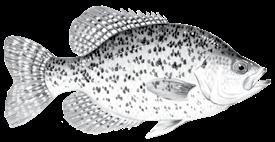
LAVON: Water lightly stained; 75 degrees; 2.34’ high.
Catfish are good on punch bait.
LEWISVILLE: Water stained; 80 degrees; 2.47’ high. White bass are fair on slabs, spoons and live bait. Hybrid stripers are fair on slabs and live bait. Catfish are good on cut shad. Crappie are fair on minnows and jigs.
LIMESTONE: Water stained; 84 degrees; 0.17’ high. Largemouth bass are good on chatter baits, Texas rigs, and spinner baits. Crappie are good on minnows. White bass are fair on slabs. Catfish are good on cut bait and large minnows.
LIVINGSTON: Water stained; 76 degrees; 0.39’ high. White bass are good on slabs. Catfish are fair on prepared bait and shad.
MARTIN CREEK: Water lightly stained; 89 degrees; full pool. Largemouth bass are fair on Texas-rigged worms and swimbaits. Crappie are good on minnows and jigs. White bass are good on jigging spoons. Catfish are good on punch bait and worms.
MER-
EDITH: Water stained; 68 degrees; 46.14’ low. Sand bass are good on spoons and soft plastics. Walleye are good on minnows, worms, jerkbaits and slabs. Catfish are good on cut bait and frozen shad.
O H IVIE: Water lightly stained; 77 degrees; 22.72’ low. Largemouth bass are fair on jigs, top-waters and frogs. Crappie are fair on minnows and jigs. White bass are fair on minnows. Catfish are good on cheese bait and stink bait.
OAK CREEK: Water lightly stained; 80 degrees; 18.95’ low. Largemouth bass are good on top-waters and crankbaits. Crappie are good on jigs. Catfish are good on cut bait.
PALESTINE: Water stained; 74 degrees; 1.13’ high. Crappie are good on jigs and minnows. White bass and hybrids are good on slabs. Catfish are good on nightcrawlers and punch bait.
POSSUM KINGDOM: Water lightly stained; 82 degrees; 0.10’ high. Stripers are fair on live bait. White bass are fair on slabs. Catfish are good on cut shad and punch bait.
PROCTOR: Water stained; 76 degrees; 0.95’ high. White bass are fair on soft plastics and inline spinners. Crappie are fair on minnows and jigs.

RAVEN: Water lightly stainrf; 70 degrees. Largemouth bass are good on soft plastics.
nows. Catfish are good on cut shad and punch bait.
SPENCE: Water stained; 80 degrees. 47.99’ low. Largemouth bass are good on soft plastics. Catfish are good on blood punch bait.
STILLHOUSE: Water stained; 80 degrees; 2.13’ low. Largemouth bass are fair on top-waters and soft plastics. White bass are fair on slabs.
TAWAKONI: Water lightly stained; 77 degrees; 0.89’ high. Largemouth bass are good on crankbaits, flukes and frogs. Hybrid stripers and white bass are good on slabs, swimbaits and live bait. Catfish are good on punch bait and dip baits.
TEXANA: Water stained; 80 degrees; 2.69’ low. Catfish are good on trotlines.
FORK: Water stained; 82 degrees; 0.38’ high. Largemouth bass are good on top-waters, frogs, crankbaits and Carolina-rigged soft plastics. Crappie are fair on minnows and jigs. Catfish are fair on prepared bait and cut
Largemouth bass are fair on spinner baits and Texas rigged worms. White bass are good on top-waters, swimbaits and slabs. Catfish are good on punch bait.
LBJ: Water stained; 75 degrees; 0.28’ low. Largemouth bass are good on jigs and Texas-rigged soft plastics. Crappie are fair on minnows.
MILLERS CREEK: Water stained; 80 degrees; 1.43’ low. Largemouth bass are slow. Crappie are fair on minnows and jigs. White bass are fair on slabs and soft plastics. Catfish are slow.
NACOGDOCHES: Water stained; 83 degrees; 0.05’ high. Largemouth bass are fair on glide baits and bladed jigs. Crappie are good on minnows and jigs.
NACONICHE: Water stained; 82 degrees; 0.50’ high. Largemouth bass are fair on jerkbaits, soft plastics and crankbaits. Crappie are good on minnows. Catfish are slow.
NASWORTHY: Water lightly stained; 79 degrees. 1.03’ low. Largemouth bass are good on soft plastics. Crappie are fair on jigs. Catfish are fair on cut bait and stink bait.
NAVARRO MILLS: Water stained; 75 degrees; 1.57’ high. Largemouth bass are good on soft plastics. White bass are slow. Crappie are fair on jigs and minnows. Catfish are good on shad and perch.
RAY HUBBARD: Water stained; 80 degrees; 0.28’ low. White bass are good on swimbaits, tail spinners and lipless crankbaits. Crappie are fair on minnows and jigs. Catfish are good on punch bait.
RAY ROBERTS: Water lightly stained; 80 degrees; 1.82’ high. Largemouth bass are fair on plastic worms, crankbaits and football jigs. White bass are fair on slabs. Catfish are good on cut bait.
RICHLAND CHAMBERS: Water stained; 82 degrees; 0.77’ high. Largemouth bass are fair on crankbaits, jigs and soft plastics. White bass are slow. Hybrid stripers are good on live shad. Catfish are fair on cut bait and shad.
SAM RAYBURN: Water stained; 80 degrees; 0.45’ high. Largmeouth bass are fair on soft plastics, jigs and top-waters. White bass are good on slabs. Catfish are good on cut bait.
SOMERVILLE: Water stained; 85 degrees; 0.56’ high. Largemouth bass are fair on crankbaits and spinner baits. White bass are good on spoons. Hybrids are good on cut bait and mussels. Crappie are good on jigs and min-
TEXOMA: Water stained; 74 degrees; 10.38’ high. Largemouth bass are fair on soft plastics. Stripers are fair on live bait and swimbaits. Catfish are good on punch bait and cut bait.
TOLEDO BEND: Water stained; 81 degrees; 0.61’ low. Largemouth bass are good on frogs, top-waters, swim jigs, crankbaits, and Carolina rigs. Crappie are good on jigs and minnows.
TRAVIS: Water stained; 82 degrees; 43.48’ low. Largemouth bass are good on worms, creature baits and swimbaits.
WACO: Water stained; 78 degrees; 0.65’ high. Largemouth bass are fair on crankbaits and silver spoons. Crappie are good on minnows and jigs.
WALTER E LONG: Water stained; 85 degrees. Largemouth bass are good on lipless crankbaits, spinner baits and A-rigs.
WHITNEY: Water lightly stained; 80 degrees; 1.55’ high. Striped bass are fair on live bait. Crappie are fair on jigs and minnows. White bass are good on slabs. Catfish are good on cut bait.
WRIGHT PATMAN: Water stained; 79 degrees; 7.54’ high. Crappie are fair on jigs. Catfish are good on stink bait.

By Logan Johnson For Lone Star outdoor newS
Afghan War and shark-fishing veteran Cris Southers was heartbroken when a client told him he had lost his passion for fishing when he lost his arms. The client booked the beach charter, content to experience fishing by the only means he saw left — spectating.
“That just blew me away,” Southers said. “So, I went home and began searching for a reel system that would allow amputees to fight fish without electric assistance or outside help.”
His search returned void of any solution. Instead, he discovered a calling and determination to create one himself.
“I decided I was going to figure out a way for amputees to regain their passion and maybe even create new passion for those who never had the ability to fish in the first place,” Southers, who served as a sniper with the 101st Airborne in Afghanistan from 2010 to 2011, said. “We lost a lot of guys over there. And even more came back with amputations and all kinds of injuries.”
When he got home, fishing was his lifeline.
“If I’m being honest, I don’t know where I’d be right now if I didn’t have that outlet,” Southers said. “Catching big fish from the beach and offshore was the only thing that really kept my head
right.”
But he was haunted by the thought of those who didn’t have this therapy, and he knew that was a reality for many veterans.
“Some of them didn’t just lose limbs — they lost their passion. They lost the one thing that helped them feel normal. My number one goal has been to lower the suicide rate among veterans. I do that by helping them build confidence and independence, helping them do something they never thought they could again.”
Southers started prototyping that would continue for nearly a decade.
“I tore apart an elliptical machine, tried chains — those corroded. Belts stretched and slipped. I eventually discovered a flex shaft, and that’s when the light bulb really came on,” he said.
This was his breakthrough that would allow power to transfer from custom-built pedals and hand cranks to a shark-tier reel with virtually any distance between the two.
The idea got closer to a built-out reality as Southers got resourceful.
“I bought a lathe off Amazon, a computer, a 3-D printer, taught myself 3-D modeling software, and started printing my own reel parts in my living room,” he said. “I had to make my own side plates and internals just to get the gearboxes to work.”
But Southers didn’t want to make fishing easier — just more accessible. “I didn’t want electric reels,” he said. “That’s not what these guys want. They want to
sweat. They want to wake up sore the next day. They want to earn it and feel accomplished.”
The custom reel systems evolved quickly while preserving the au thenticity of fighting a shark via reel mechanics. Southers built the first hand-crank, wheelchairready version in just two weeks for a young girl weakened by chemo therapy.
“She could barely walk, but she wanted to see a shark — and catch one,” he said. “She sat in the beach wheelchair and reeled in a 9- or 10foot hammerhead.”
Southers was ready to assist without her knowing.
“I was on the trailer, on the main reel,” he said. “If she got ex hausted, I could help without her feeling it. I even built it so the han dle wouldn’t hit her hands when she stopped. It only moves when they’re the ones turning it.”
These reel mechanisms have passed the “torture test” by South ers’ standards, having undergone many bouts of intense pressure in shark battles.
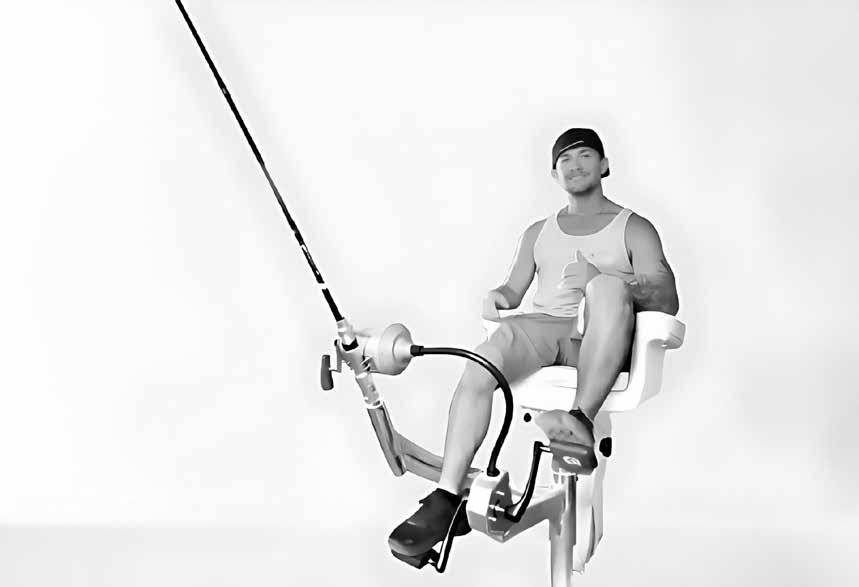
“I’ve had two 5-year-olds bring in a 740-pound tiger shark — one kid on each side, reeling with both hands,” he explained. “The kids love it. The adults love it. Everybody loves it. Why use one hand when you can use both?”
Southers now holds the only known patents for a foot-operated and manually remote-operated fishing reel.
“I sold my house. I sold everything I could to keep this going,” he said. “Every day I hear about another buddy killing himself.
That’s why I’m doing this. I didn’t even want patents. To me, that felt like holding back the cure for cancer. But the American Legion veteran’s organization pushed me and paid for the patents.”
Southers runs Land Yacht Fishing, a shark fishing and party charter on the shores of Port Aransas.
“I really did everything on my own,” he said, reflecting on his Peda-Reel and double-handle reel systems. “Now I’m just looking for the right partner to help spread
the impact of my inventions.”
Southers’ passion is active and spreading almost every day on the Port Aransas Beach.
“There’s not a dry eye on the beach, especially when someone who needs my inventions uses them,” he said. “I know it’s going to change the fishing industry. It’s going to help a lot of people experience the joy of fishing — disabled or not.”

FISHERMAN’S BODY FOUND IN HARBOR
On June 19, a body was found in the Rockport Harbor. Texas game wardens and the Rockport Volunteer Fire Department responded to the scene. Preliminary information indicated the deceased had been fishing from a pier in the harbor. It is unclear how the deceased entered the water. The case is currently under investigation and the identity of the 76-year-old male victim is known but wasn’t immediately released pending notification of next of kin.
BIG SEIZURE OF RED SNAPPER
The Coast Guard and partner agencies interdicted and detained 13 Mexican fishermen engaged in illegal fishing and seized approximately 1,500 pounds of fish in federal waters. After interdicting the lanchas, crews took the fishermen into custody, brought them ashore, and transferred them to U.S Homeland Security Investigations personnel for processing. Coast Guard personnel also seized approximately 1,500 pounds of red snapper, along with fishing gear and equipment found on board the vessels.
BUSY HOLIDAY WEEKEND FOR WARDENS
Over the Memorial Day weekend, game wardens conducted 10,897 vessel checks, resulting in 1,374 citations and 1,951 warnings given. A total of 53 boating while intoxicated charges were filed, the highest in the past 5 years. Seven others were charged with driving while intoxicated and 21 other arrests were made. Wardens also responded to six boating incidents or collisions, one of which resulted in a fatality at Grapevine Lake. There were also two drownings reported at Elmendorf Lake and on the Red River. Wardens also reported a significant number of personal watercraft operators without required boater education and responded to multiple calls for paddler assists, medical emergencies and supported partner emergency response agencies. Multiple water and boat rescues were reported statewide.
On Lake Travis, wardens launched during a Memorial Day evening thunderstorm into winds upwards of 60 mph and lightning to rescue five people onboard a distressed vessel. All individuals were brought to safety.
On the Falcon International Reservoir, wardens rescued a 5-year-old girl on an inflatable tube being blown away from shore. The child, wearing no life jacket, was picked up by wardens before winds could capsize her tube. She was reunited with her family, who also received education on the importance of personal floatation devices.
In a separate incident, game wardens supported a local sheriff’s office with a barricaded suspect in a domestic violence case. The suspect’s wife and children were safely evacuated from the residence.
Continued from page 8
highlight Lake Fork’s trophy bass fishing.
“When you paint on brick it absorbs heat from the sun, causing paint to dry quickly,” Gonzales said, “We did not have much wiggle room to blend so we learned a lot during the process.”
The process began on a Friday and through full workdays, the team had their work signed, sealed and delivered by Tuesday afternoon.
“It rained one day and despite working around the weather, we got the job done,” Gonzales said. “The owner was extremely happy with the final result, and we encountered so many nice people that drove by with compliments.”
With a true passion for art, Gonzales said their love for the outdoors is just as strong. Brannan has been obsessed with it since birth and has taught their family its importance.
“From going to the lake to the coast, and deer hunting — we are just outdoorsy people,” Gonzales said. “It is really a family legacy we have established and are trying to carry on.”

Through all of the success Gonzales has achieved, she has learned to not be fearful of trying new things. Her favorite quote? “Make it exist and then make it good.”
“Do not worry about perfection off the bat — just do it, try it out, and strive to improve,” Gonzales said. “Reach out to people in your community, learn from YouTube — someone’s experience is always going to be helpful.”
Continued from page 8
“The former owner approached me with the idea,” he said. “With a full-time job as a lineman, I wasn’t sure if I could handle taking on the business venture. My wife told me that if it was something that I really wanted to do, that we should go for it.”
Five years later, as a father of two and a lineman, Sumney has made KDEN a family business. He contracts an individual to shoot the baits in the mold for him. From there his family helps handle the rest.
“My wife, mother-in-law, and sister-in-law help
with the labeling, packaging and shipping,” he said. KDEN Lures can be purchased online, as well as at many popular tackle shops and sporting goods stores in Texas and Louisiana.
Anglers up and down the Gulf Coast are using the lures to pursue speckled trout, redfish and flounder, and freshwater anglers are even using them to catch bass.
“I am excited to see what the future holds,” Sumney said.



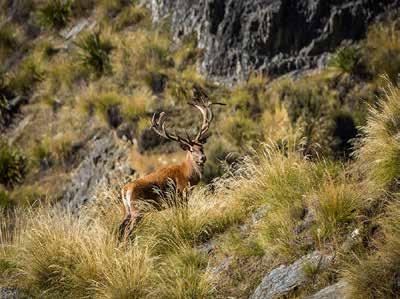



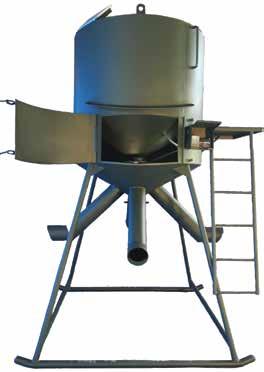


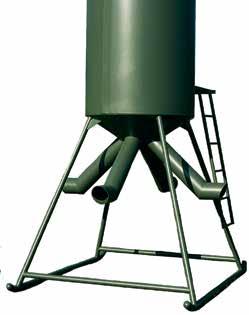

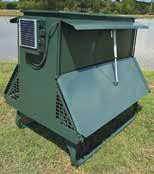
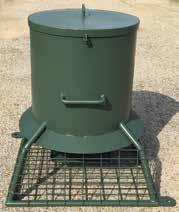
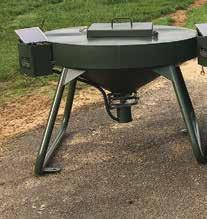
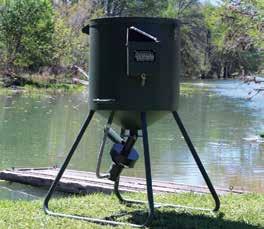
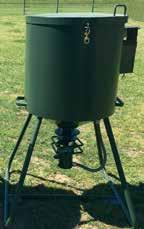



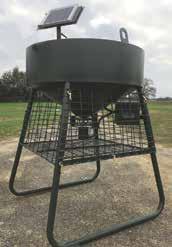
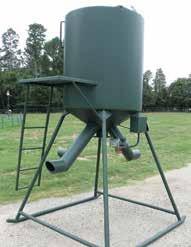
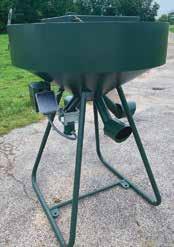
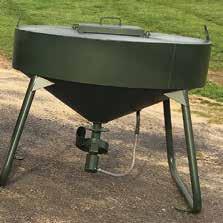
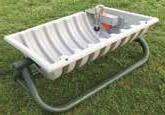
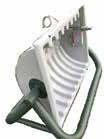


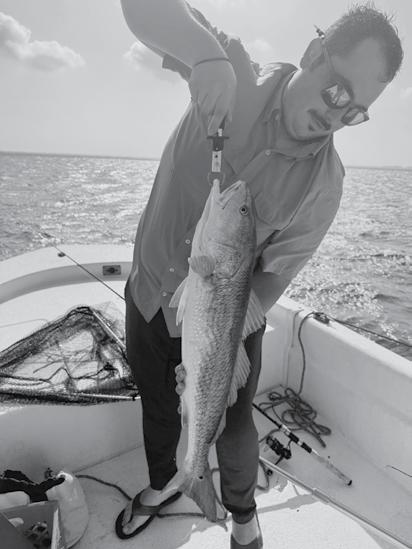
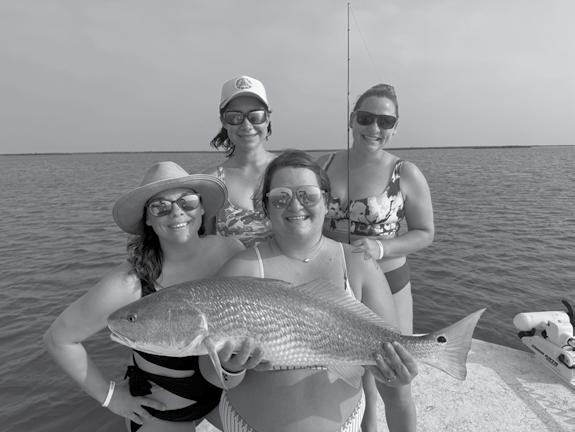
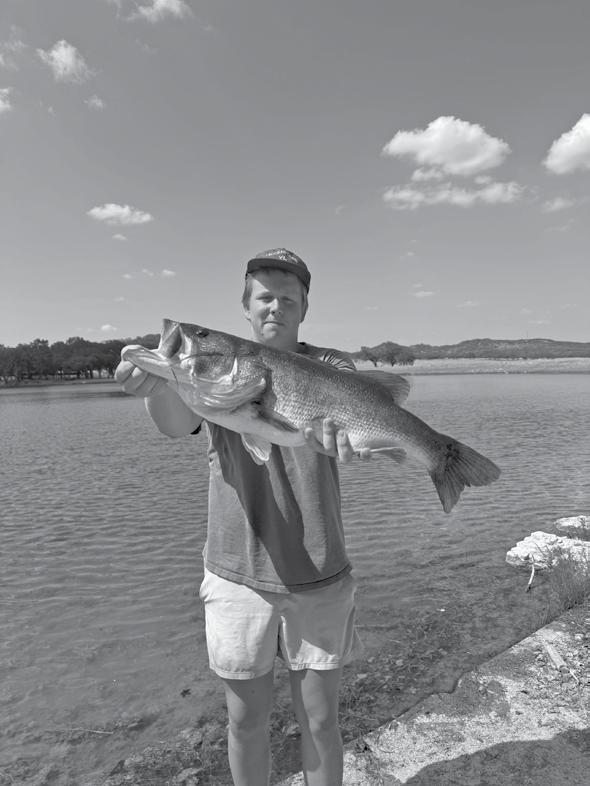


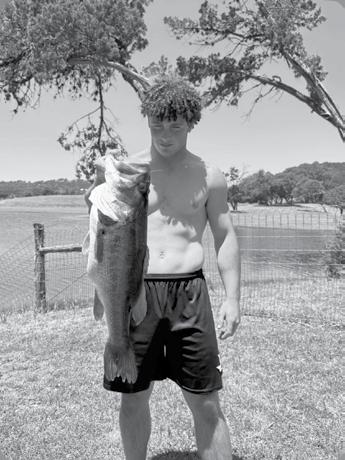







Get ready folks, it’s that time of year again when hunters and outdoorsmen from across Texas head south to the McAllen Convention Center to experience one of the best outdoor shows in the country July 18-20 — the Texas Hunters and Sportsman’s Expo.
“We have had solid crowds through the years and the show’s attendance continues to grow each year,” said show director Justin Curl. “This three-day weekend event is expected to draw several thousand hunting and fishing enthusiasts and visitors from both sides of the border.”
Exhibits for everyone, including women and children, and all types of retailers representing all price levels will be on hand.
‘We have always felt that expos and shows like ours are the perfect opportunity to get the children out of the house and enjoy the outdoors,” Curl said. “I feel it’s imperative to get the kids involved with the outdoors at an early age. This is why we thank Academy Sports & Outdoors for their yearly commitment.
“Another thing we want to focus on this year is the fact that we are going to have items for everyone, as usual, and a variety of exhibits to enjoy.”
Want to go on a great hunt? The Texas Hunters & Sportsman’s Expo is recognized as the highest-quality hunting and fishing show in South Texas, with outfitters from across the United States, Canada, Mexico and Africa booking hunts for white-tailed deer, big game, exotics, bear, moose, elk, mule deer, turkey, quail, dove, pheasant and waterfowl.
Is fishing more your thing? Come and speak with guides for bass and saltwater game fish. Also, a huge display of boats, motors, rods, reels, fishing lights, tackle and more are waiting for you.
Manufacturers and dealers will also be on-hand offering special show prices on hunting blinds, ATVs, camouflage clothing, ranching equipment, tractors, hunting accessories, supplies and more.
“This is a show the entire family can enjoy,” Curl said. “Wildlife art, hand-crafted rustic furniture, barbecue pits, smoked meats, gourmet foods and exotic and silver jewelry, are just a few of the exhibits and attractions.”
Feature attractions:
• Wildlife artist Don Breeden
• Gary Roberson – Predator Hunting Expert
• Daily door prizes
• Hourly giveaways
• CCA UTV Raffle
• Frank Addington, “The Aspirin Buster”
• Live rattlesnake pit – compliments of Bert Ogden
• Pedro Sors, host of Con Cana y Carette
• Live country music from Southern Ashes Band
Admission Prices: (Includes a wristband that allows unlimited entry)
Adults $20
Senior Citizens $15
Children 12 and under Free
Show Dates and Times:
Fri., July 18 5 p.m.-10 p.m.
Sat., July 19 10 a.m.-7 p.m. Sun., July 20 11 a.m.-6 p.m.
For more information, call (956) 664-2884 or visit huntmcallen.com.

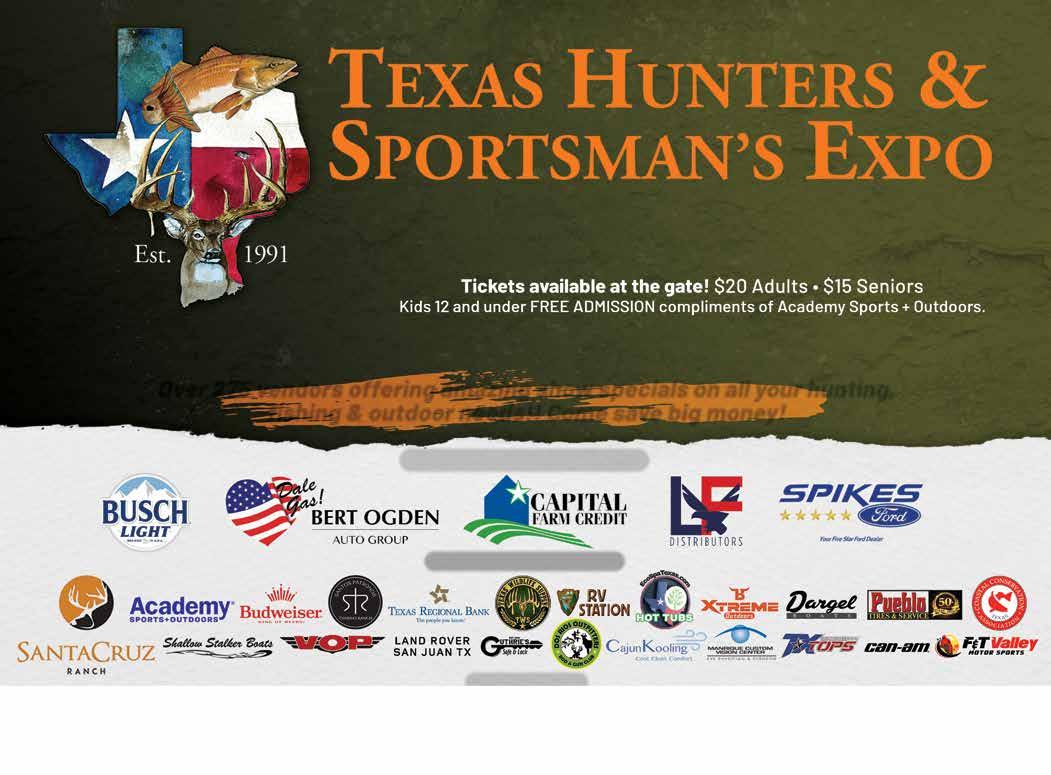


Lone Star outdoor newS
At the National Professional Fishing League tournament on Oklahoma’s Lake Eufala, Chad Marler, a Jasper pro who has provided his tips and reports in several Lone Star Outdoor News articles, topped Alabama’s Gerald Swindle and the rest of the field to win the NPFL Stop Four, and $100,000.
After a storm-delayed start, Marler took control on the final day with a 17-pound, 11-ounce bag, anchored by an 8 pound, 1-ounce largemouth. His two-day total of 33 pounds, 12 ounces held off Swindle, who finished with 33 pounds, 11 ounces.
Most of the pros fished shallow, targeting bass in the bushes. Marler used a custom-built Hilandero Blades Spinnerbait, burning it through bushes to trigger reaction strikes.
On the final day, he ran to a new stretch of water he hadn’t touched since practice.
“I left that area alone during the last day of practice, just in case I needed it,” Marler said. “I didn’t know if it’d be clean or dirty, but I had a feeling. The water was a little clearer, and those big girls were ready to eat that spinnerbait. On the third cast, she ate it — an 8-pounder.”
Marler had a quick limit and the kicker sealed the win. He said the early bite was key on the lake.
“If you didn’t have your fish by 10:30, you were in trouble,” he said.
Swindle also fished flooded bushes with a Buckeye spinnerbait, but targeted the outer edges with unseen cover.
“Every good bite came from those outof-sight bushes,” he said. “Whenever that Buckeye bumped one, they’d crush it.”
Continued from page 9
started repairing reels and then one day when I came home from school in the mid 90s, we got more into fishing tackle.”
Moore said his childhood revolved around visiting tackle stores and taking many fishing trips to feed their family. This experience is dear to his heart, and he wants to share this passion with customers worldwide.
Southwestern Parts carries one of the largest reel parts inventories in the world — even some discontinued by the manufacturer. With an average of 250 reels per week in service during their peak season, customers are satisfied and remain loyal.
“What started as a sideline business for us has developed into one of the largest fishing reel repair businesses in the world,” Moore said. “We can do warranty work for Abu-Garcia, Shimano, Daiwa, Penn and Zebco.”
Their skilled team even includes employees with more than 30 years of
knowledge. Moore said this team is dedicated to help you in any way and answer questions about the fishing world.
“It is easy to get overwhelmed with information when it comes to fishing as the techniques, and opportunities are endless,” Moore said. “Fishing is as simple as you make it and there are people like us that want to help you. Remember, you can still catch a fish with just a worm.”
Being exposed to the outdoors and having the opportunity to fish is something Moore believes everyone needs to experience.
“This hobby is something you can do for the rest of your life,” he said. “You can do it from any age group — some of my customers are 80 to 85 years old and are still fishing.”
Moore invited everyone to stop by and say hello at the new location at 321 E. Northwest Hwy. in Grapevine.





SABINE LAKE: 82 degrees. Speckled trout are good on live shrimp under a popping cork and soft plastics. Redfish are good on live shrimp. Black drum are fair on live shrimp on Carolina rigs. Flounder are good on soft plastic jigs tipped with shrimp.

BOLIVAR: 78 degrees. Redfish are good on live shrimp, live mullet and soft plastics. Speckled trout, sand trout and black drum are good on live shrimp. Flounder are fair on soft plastics, live shrimp and live mullet.
TRINITY BAY: 76 degrees. Redfish are good on soft plastics and live shrimp under a popping cork. Speckled trout are fair on live shrimp under a popping cork and soft plastics. Black drum are fair on live shrimp. Flounder are fair on live shrimp and soft plastics.
EAST GALVESTON BAY: 87 degrees. Speckled trout are good on croaker and live shrimp. Redfish are good on live shrimp and soft plastics. Flounder are fair on soft plastics, live shrimp and live mullet.
GALVESTON BAY: 87 degrees. Speckled trout are good on croaker and live shrimp. Redfish are good on live shrimp and soft plastics.
WEST GALVESTON BAY: 87 degrees. Speckled trout are good on croaker and live shrimp. Black drum are fair on live shrimp. Redfish are good on live shrimp and soft plastics.
TEXAS CITY: 78 degrees. Speckled trout are good on live shrimp, croaker and soft plastics. Redfish are good on live shrimp and mullet.
FREEPORT: 81 degrees. Speckled trout are
WEST MATAGORDA BAY: 80 degrees. Speckled trout are fair on croaker and topwaters. Redfish are slow. Flounder are fair on live shrimp, mullet and soft plastics.
PORT O’CONNOR: 80 degrees. Speckled trout are good on live croaker. Jack crevalle and bull redfish are good on blue crab and Spanish sardines. Redfish are fair on blue crab and Spanish sardines.
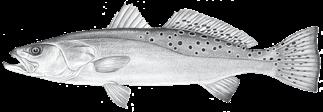
SAN ANTONIO BAY: 80 degrees. Speckled trout are good on croaker. Redfish are good on live shrimp under a popping cork and freelined croaker.
ROCKPORT: 80 degrees. Speckled trout are good on live shrimp, piggy perch and croaker. Redfish are fair on shrimp, mullet, and menhaden. Black drum are fair on live and dead shrimp.
REDFISH BAY: 80 degrees. Speckled trout are good on croaker. Black drum are fair on dead shrimp. Redfish are fair on shad.
PORT ARANSAS: 80 degrees. Redfish are good on live shrimp, finger mullet and shad. Speckled trout are good on croaker and live shrimp.
CORPUS CHRISTI: 80 degrees. Speckled trout are good on live croaker. Black drum are good on dead shrimp. Redfish are fair on shad.
BAFFIN BAY: 83 degrees. Speckled trout and redfish are good on soft plastics and topwater lures.
PORT MANSFIELD: 82 degrees. Speckled trout and redfish are good on soft plastics and top-water lures.
SOUTH PADRE: 83 degrees. Speckled trout are fair on live shrimp. Redfish are good on cut mullet and shrimp. Black drum are good on shrimp. Mangrove snapper are good
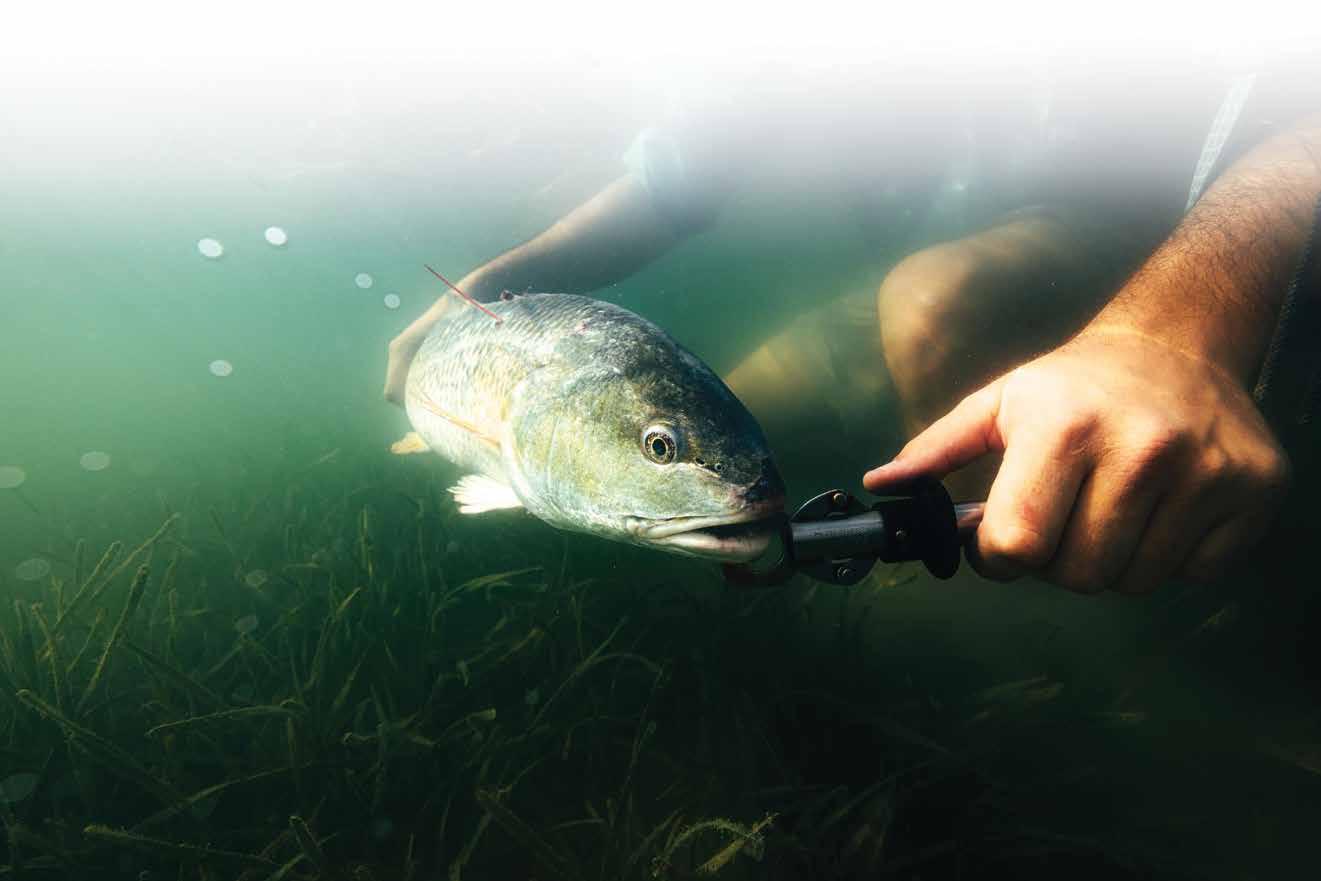
Continued from page 1
were small but willing to strike top-water lures and soft plastics.
“I was hoping to find some redfish but all I could find were speckled trout,” he said. “I guess the high tides had the reds spread out, and the poor water clarity made targeting them with lures difficult.”
Matagorda-area guide, Capt. Chris McKinley, said runoff following the storms had speckled trout stacked up along the south shoreline of East Matagorda Bay. Soft plastics bounced along the bottom over scattered shell in waist to chest deep water produced limits in the 18-20-inch range for his anglers.
“You could see the line of freshwater on the surface in the middle portion of East Matagorda Bay,” he said. “The southern half of the bay had decent water clar ity, while the northern portion of the bay was pretty dirty.”
McKinley said redfish were also stacked up near marsh drains along the edges of the ICW, where freshwater runoff was pushing swarms of baitfish and shrimp out of the marshes. Most of the reds were in the mid-slot range and were willing to strike soft plastic swimbaits.
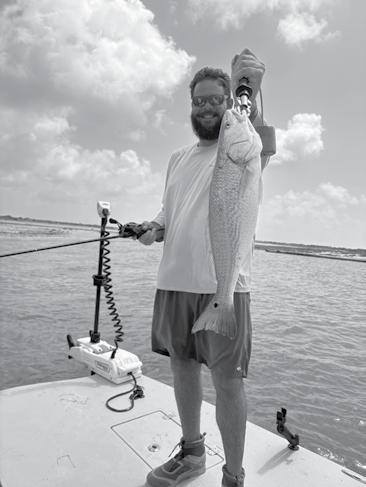
Many Sabine-area anglers reported the tides were super high, which kept the freshwater runoff from leaving the back lakes and marshes. Some found good numbers of redfish in the back lakes, but they were tough to catch because the water was so dirty. Those who had success were using scented soft plastics under popping corks.
Capt. Chris Phillips said the freshwater runoff has had speckled trout stacked up along the edges of the Sabine Pass ship channel, as well as along the jetties.
“On the channel, the fish are holding tight to the bottom in the saltiest water they can find over drop-offs and shell humps in anywhere from 7 to 15 feet of water,” he said. “The bite at the jetties has been pretty consistent too, especially during an incoming tide.”
Phillips’ anglers have been catching the specks on live shrimp and soft plastics. Good numbers of sheepshead and some slot redfish have been in the mix.
Anglers fishing the Keith Lake complex reported that redfish were scattered and hard to find due to elevated tides and poor water clarity. They did find good concentrations of speckled trout over oyster shell in 3-6 feet of water.
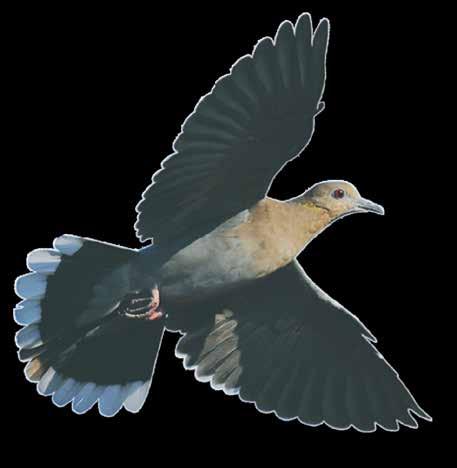

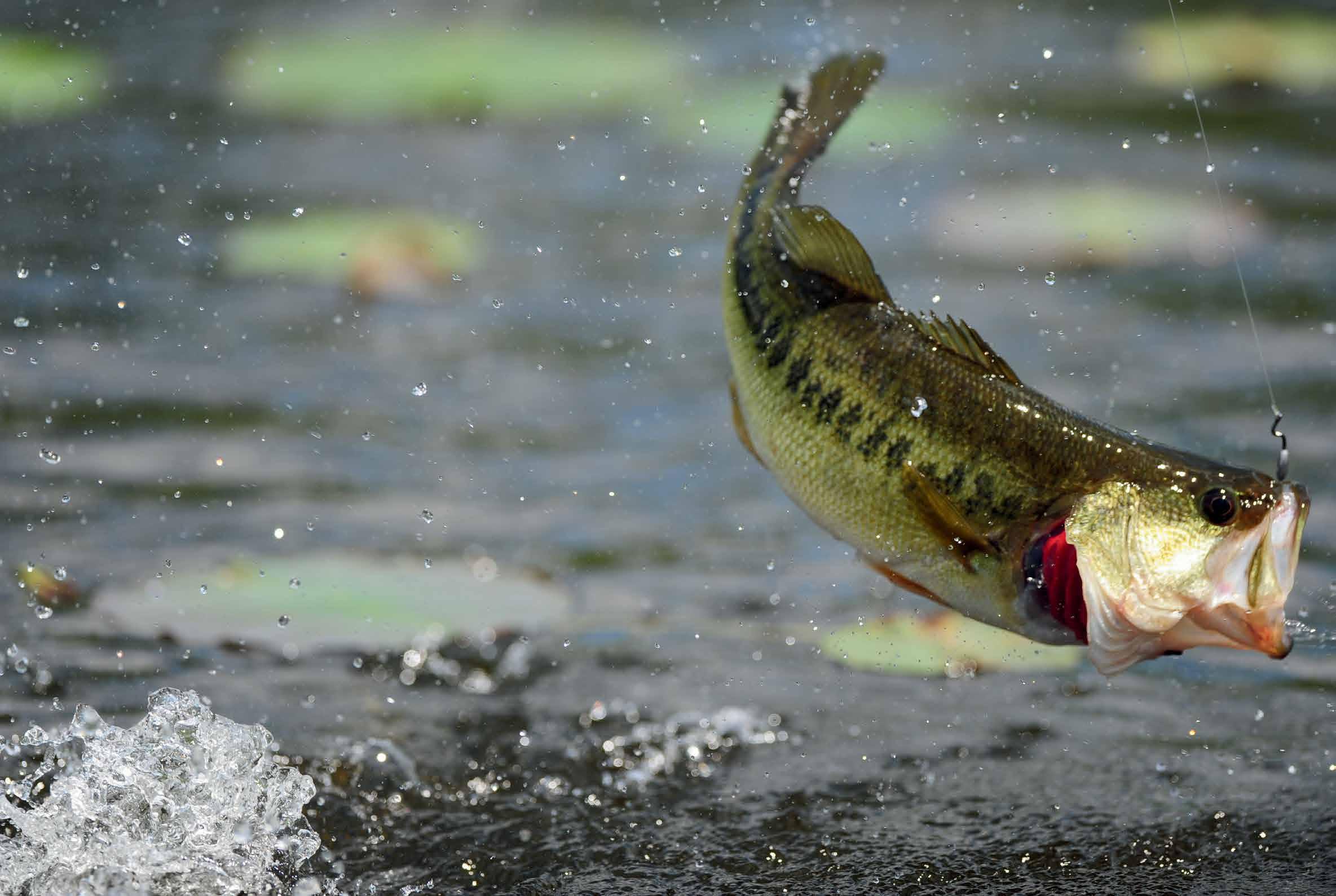
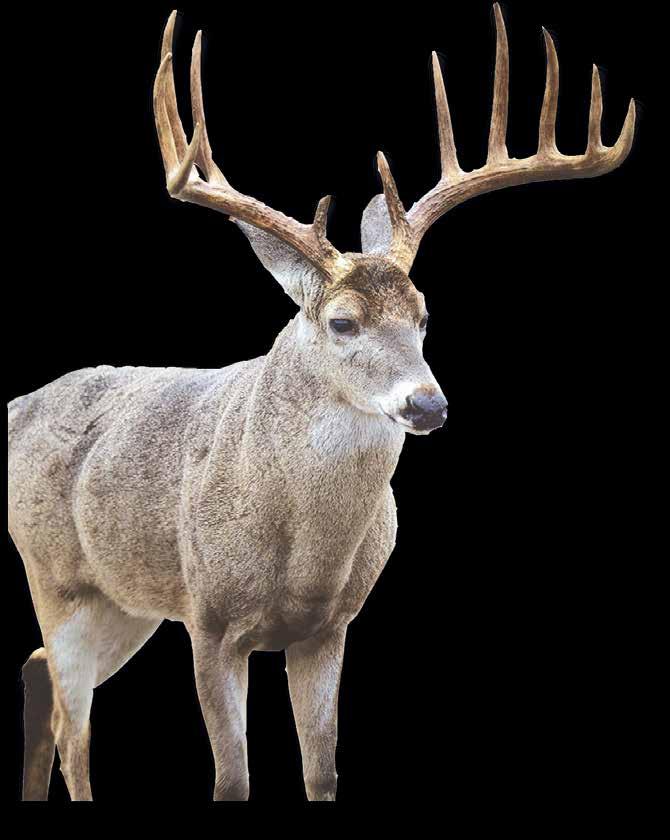





Solution on Page 24

ACROSS
3) Guadalupe County’s seat
6) TV host and chef
8) Panola County lake
9) The tom’s weapons
10) Hill Country lake
12) Italian shotgun brand
14) Texas’ state dog (two words)
16) Org. For duck enthusiasts
18) Salmon species
20) A dabbler
21) A trap type
23) A spaniel
24) Duck call brand
26) Stephens County lake
29) A nontoxic shot
30) Muleshoe’s county
32) Trout species
33) Sinker type
34) South Texas lake near Alice
36) Stephenville’s county
39) A turkey sound
40) The female duck
41) Fishing knot type
42) A hog dog
43) Centerville’s county
44) Border lake
45) Coastal bay
Conservation Force added Joseph Goergen as director of conservation strategies.
Boat company acquisition
Offshore center console boat manufacturer Twin Vee acquired Bahama Boat Works.
Colbert named Ruger VP,
Sturm, Ruger & Company named Sarah Colbert as the vice president, general counsel and corporate secretary.
Cole Fine Guns and Gunsmithing is looking for a technical services coordinator to join the team.
Seaguar appointed Christopher Rosella to assistant sales manager and John Whelan to assistant marketing manager.
Brownells
Frank Brownell, 85, who held the positions of President, CEO, and Chairman of the Board at Brownells, died June 18 after a lengthy illness.
John Brewer “JB” Hodgdon, Chairman Emeritus of Hodgdon Powder Company, died June 13 at the age of 88.
Tim Carini was appointed the publisher of the In-Fisherman brand.
DOWN 1) A duck favorite 2) Safari destination 4) Town on the Brazos 5) Minnow species 7) Ammo brand 10) A creature bait 11) Turkish shotgun brand 13) Rifle brand
14) Meridian’s county
15) Town on the Guadalupe
17) Cherokee County’s seat
19) Reveille’s (A&M mascot) breed 22) Jig type
23) The tail fin
25) Good white bass river
27) Rains County’s seat
28) An African antelope
30) Front of the boat
31) Bass ambush spot
32) Dog known for rabbit hunting
33) Two-legged shooting rest
35) Big game hunters’ org.
37) Henderson County’s seat
38) San Marcos’ county
40) Greenville’s county

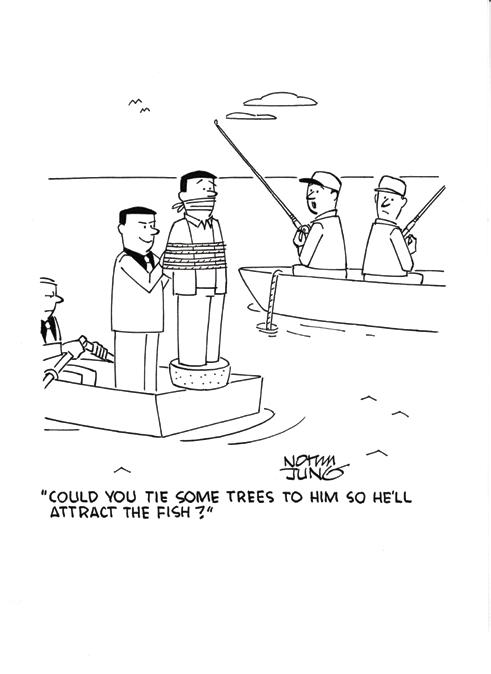
*email LSON your favorite recipe to editor@lonestaroutdoornews.com.
Sauce
1/4 cup butter
1/2 cup diced onion
1/4 cup diced bell pepper
1/4 cup chopped mushrooms
1 1/2 tsps. minced garlic
2 tbsps. flour
1 1/2 tsps. Creole seasoning
2 cups half-and-half
1/2 can condensed cream of mushroom
1/2 lb. peeled crawfish tails or shrimp
Melt butter in a large skillet and sauté
onion and bell pepper until soft. Add mushrooms and garlic and cook until mushrooms release liquid. Add flour and Creole seasoning and mix well. Slowly add enough half-and-half to form a paste, stirring constantly. Add condensed soup and mix well. Cook until sauce thickens enough to coat the back of a spoon. Add
remaining half-and-half and crawfish and heat until hot.
Fish 10- to 12-ounces black drum fillets, thawed
1 to 2 tbsps. Creole seasoning
2 tbsps. olive oil
2 tbsps. chopped green onions
2 tbsps. chopped parsley
Pat fillets dry with a paper towel and sprinkle both sides with Creole seasoning. Heat 2 tbsps. oil over medium-high heat in a large skillet. When sizzling, add fillets. Lower heat to medium. When edges of the fillet turn pale or whitish, flip them. When cooked, plate immediately and cover with sauce. Garnish with green onions and parsley and serve hot.
—LSU AgCenter
2 tbsps. butter, divided
1 large onion, finely chopped
1 cup breadcrumbs
1 cup milk
2 pounds venison, ground
2 eggs, lightly beaten
1 tsp. salt
1 tsp. ground black pepper
1/2 tsp. ground nutmeg
1/2 tsp. ground allspice
1/2 tsp. ground ginger
3 cups beef broth
1/3 cup all-purpose flour
8 ozs. sour cream
1/2 cup lingonberry jam
Preheat oven to 350 degrees. Melt 1 tbsp. butter in a pan and sauté the onions over medium heat until translucent and slightly browned. Place breadcrumbs in a mixing bowl and add milk. Mix well and let stand until crumbs are rehydrated. Place onions, ground venison, eggs, salt, pepper, nutmeg,
allspice, and ginger in a separate mixing bowl. Mix in the breadcrumb mixture and gently combine the ingredients by hand. Form mixture into approximately 1-inch diameter meatballs. Melt the remaining butter in a pan and bring to medium heat. Add the meatballs, browning on all sides. Place meatballs in a baking dish and pour 1 cup of beef broth over them. Cover with foil and bake for 30 minutes. Remove meatballs and place on a serving dish. Be sure to save the broth. To make the gravy, heat your reserved pan and deglaze it with the broth used to bake the meatballs. In another saucepan, adding the remaining 2 cups of beef broth and whisk in flour until smooth. Add the deglazing juices. Bring the contents to a simmer and let them thicken for 5 minutes. Whisk the sour cream into the gravy. Add salt and pepper to taste. Pour gravy over the meatballs and serve with lingonberry jam.
Outback Wildlife Feeders introduces its highly innovative Herd Management Feeder Systems. First conceptualized by wildlife biologist Macy Ledbetter, these uniquely designed and engineered systems utilize their patented timed access control feature to create more management and harvest opportunities.
These systems are the Protein Feeder Access Control System and Cottonseed Feeder Access Control System. Both units are fully patented and exclusive to Outback Wildlife Feeders.
Virtually all wildlife feeders on the market have one common, yet critical deficiency. They allow deer to access the feed source at the time of their choosing, day or night. The Herd Management Feeder Systems cure that deficiency.
Utilizing the PFACS and CFACS, you set THE TIMER to create specific times each day that the protein and cottonseed feed attractants are made accessible. Leading up to, and during the season, the hunter typically sets these windows of time to occur only during prime morning and evening hunting hours. As these windows of time become the only opportunity for the deer to access the feed attractants, they adapt to these feeding windows, and nocturnal feeding from protein and cottonseed feeders is eliminated.
As a result, whether it be converting mature nocturnal bucks to daylight feeding at the site, achieving proper buck to doe ratios, removing inferior deer, harvesting trophy animals, or all of the above, the Outback Wildlife Feeders’ Herd Management Feeder Systems create more harvest opportunities of target animals. In addition, PFACS and CFACS facilitate expedited genetic improvement of your deer herd and maximize the hunters’ time in the field.
The ability to set the AM and PM windows of feed access times to occur only during daylight hours also helps eliminate feed loss to raccoons and is helpful in reducing attractiveness to feral hogs. All the features of the systems add up and translate into feed cost savings.
PFACS ordering options: Factory installed on new Outback Gravity Protein Feeders; retrofit kits exclusively fit Outback Protein Feeders that you can install yourself, or Outback can deliver and install. Also 6-Tube, Magnum and Half Back PFACS units are available. CFACS is only available on new Outback Cottonseed Feeders.

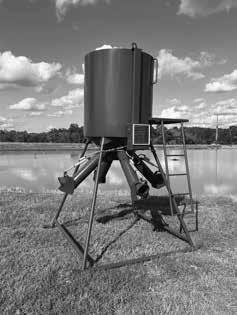

As with all Outback Wildlife Feeder products, you can trust their rugged durability and expert craftsmanship built with only top-quality American materials. All products are warrantied and serviced directly by Outback. For more information, phone (903) 734-4210 or online at outbackfeeders.com.




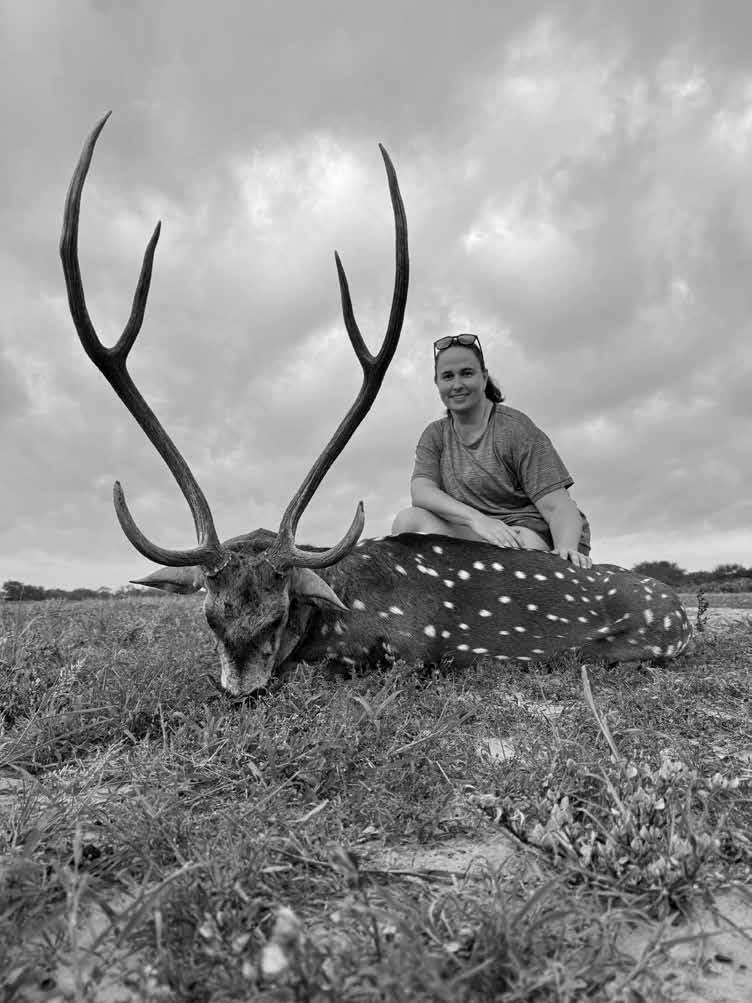
Continued from page 8
soft plastics are all producing plen ty of strikes. Most of the bass are in the 1-3-pound range, with an occa sional 4-5-pound fish mixed in.
“There are just a lot of fish to be caught right now,” Deaver said. “The bass are biting pretty consis tently, and it’s a fun time to be on Caddo Lake.”
Recent rains have muddied the water in portions of Lady Bird Lake, especially in the lower section, ac cording to guide Ander Meine.
“Focusing on areas in the upper portion of the lake has been key, as that is where the water clarity is the best,” Meine said.
Meine’s anglers have been catch ing solid numbers of bass from 1-5 pounds by skipping finesse jigs un der trees and docks. Punching mat ted vegetation with Texas-rigged creature baits also has worked.
“There’s even a sporadic top-wa ter bite going on along the edges of matted vegetation and in shady ar eas,” he said. “It’s worth chunking a top-water for a little while during the morning hours.”
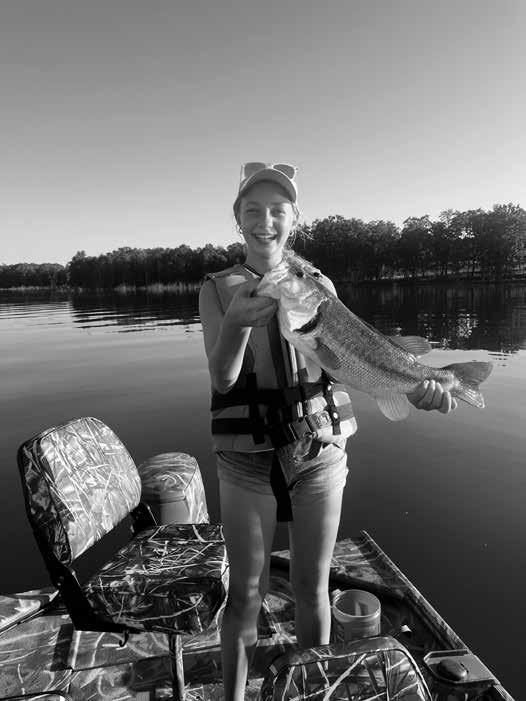
Charles Whited said largemouth bass on Canyon Lake have been feeding consistently in stretches of water with plenty of grass during the early morning hours.
“When the top-water bite slows down, switch to your favorite soft plastic presentations for the remainder of the day,” he said.
On Lake O’ the Pines, guide Brian Vickery said the largemouth are concentrated along main lake points and bridges in 10-30 feet of water.
“If you can locate large swarms of baitfish on your graph, you can bet that there will be plenty of bass nearby,” Vickery said. “The best action has been occurring early in the morning and late in the evening.”
Crankbaits, Carolina rigs, football jigs, and large shaky head worms have all been producing fish.
“Some fish have been schooling in open water, so keep your eye out, and have a top-water or lipless crankbait rigged and ready to cast in their direction if you see them,” Vickery said.
By Miguel Morales For Lone Star outdoor newS
A trip won in a company raffle led to a great axis hunt for Emily Landry.
A group of ladies, all from Cajun Industries, based in Baton Rouge, Louisiana, came to South Texas to the El Tesoro Ranch. The company enters their employees each year into a raffle, and the winners drawn get a weekend getaway at the ranch to enjoy everything it has to offer. Twelve came from Louisiana and were picked up by guides and ranch staff.
After getting settled in, they got a game plan together for what the weekend had to offer. Five women out of the group were offered an opportunity to hunt, including Emily Landry. Emily was looking forward to hunting for an axis buck.
“I’ve seen them before a few times and they’re just so beautiful and magnificent,” she said.
Guides Kendal Robinson, Jonathan Barragan, and Madison McGeorge took the hunters to the range to get them comfortable with their firearms. The women were given different calibers to shoot and see what worked best for them. They got to try a 350 Legend, 6.5 PRC, 6.5 Creedmoor, and a .308. Emily shot last out of the group and smoked the bullseye at 100 yards twice and then again at 200 yards.
“The guides did such a great job in making me feel confident in my abilities, I was so excited for the morning hunt,” she said.
The next morning Emily and her guide set out and had an eventful sit.
“We saw a stud axis but he was on the complete opposite end of a food plot, and I just hadn’t shot that far before,” Landry said. “He was around 400 yards away.”
After Emily sat all morning and watched her axis walk away, she was determined to change things up.
“I was ready to spot and stalk but we just weren’t in a position to make a move without spooking animals between us,” she said.
After the hunt, Landry went back to the range and shot multiple distances from 300500 yards and got more comfortable with her firearm.
“Then after lunch one of the activities offered was long-range shooting at 876 yards, 1,300 yards, and 1 mile. I couldn’t pass that up,” she said.
Landry hit steel at the 876 and 1,300 yard targets and felt even better about the longer shot if it were to come up.
On the second morning, as daylight was breaking, Landry and her guide started making out shapes in the food plot. Sure enough, at the far end of the food plot once again an axis buck went strolling by. As she was looking at him through the binoculars, her guide spoke.
“Pass me the sandbag off your window and get ready, he’s coming in from the left,” he said.
Landry passed the bag but hadn’t laid eyes on her buck yet, as he was in her blind spot.
“He finally came out where I could see him and he was walking in like he was on a mission,” she said. “My guide told me to get ready and he was gonna make him stop.”
The guide made a “meh” noise twice but the buck wouldn’t stop.
“We’ll just let him do his thing just be ready when he stops,” he whispered.
Not five seconds later, the axis buck stopped at an angle quartering to Landry at just 80 yards and she made the shot with a 6.5 PRC.
Her axis weighed in at 220 pounds and his main beams were each 33 inches.
Continued from page 1
“The bluegill fishing has been really good this year compared to previous years, just because of the rain,” Wells said.
He has been finding fish holding up against timber and overhanging banks.
“Both of the rivers I fish are crystal clear so you can see them as you’re going,” Wells said.
Terrestrial patterns like the Llano bug and foam beetles have been productive.
“Sometimes with the foam beetle you feel like you’re getting a lot of strikes and you’re not catching them — it’s like they are waving at it. I’m not afraid of down-sizing at this point.”
Wells recommends fly-anglers stick to flies between sizes 8-14. For leaders, he sticks with 3x tippet.
“If you’re not willing to lose the fly, you won’t be throwing it where you’re probably going to catch fish,” he said. “Going to the 3x kinda gives you more confidence to throw where you need to.”
On Lake Conroe, the bluegill are staging in spawning areas and near edges.
“What I have noticed is that the deeper water spots have different bite times,” angler CJ Azama said.
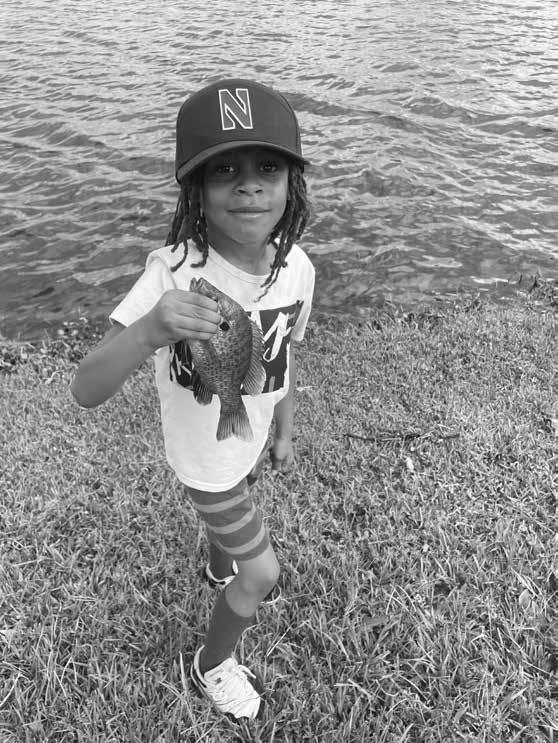
Azama is finding bluegill at all levels of the water column. At his shallow spots, he is fishing 2-4 feet below a slip cork with worms or shrimp.
“During the slower bite times I have done a little better when I went deeper,” he said. Azama is looking for transition areas where there is a shallow edge or flat and a deeper pocket of water for them to go to when the day heats up.



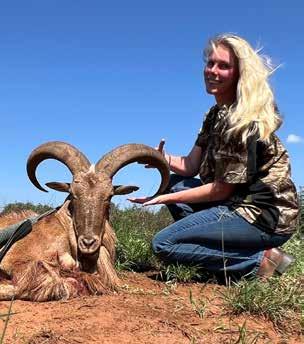
co-chair of Wyoming Game and Fish Department’s Bighorn Sheep Working Group.
New emergency rules and resolutions for public hunting lands were approved by the Oklahoma Wildlife Conservation Commission.
Commissioners approved emergency rules adding requirements for nonresident game bird hunters, banning the use of season-long duck blinds on U.S. Army Corps of Engineers property and establishing rules for a new wildlife management area.
The rules include a new requirement for nonresident hunters to buy an additional $100 permit to hunt game birds on WMAs.
Lutz has worked closely with the Wild Sheep Foundation for many years and serves as an Ex-Officio member of WSF’s Professional Resource Advisory Board.
—WSF
During the fall of 2024, Montana Fish, Wildlife & Parks wardens requested help from the public in poaching cases involving headless deer and elk on private property in Blaine and Phillips counties.





Rules for the new Herron Family WMA in McCurtain County were approved. The 17,576-acre property will be open this fall to only Oklahoma residents at the request of the family who owns the land.
—OWCC
The North Dakota Game and Fish Department’s annual spring breeding duck survey conducted in May showed an index of about 2.66 million birds, down from 2.9 million in 2024 and 3.4 million in 2023.
The 2025 breeding duck index exceeded the long-term (1948-2024) average by 7 percent, according to Mike Szymanski, Department migratory game bird supervisor.
“Things are continuing to decline a little bit as far as duck populations go,” he said. “The mallard population estimate was down 26 percent from last year and is the lowest estimated mallard breeding population on our survey since 1993. Blue-winged teal, greenwinged teal and pintails also had significant population declines, whereas the declines for gadwall, shovelers and ruddy ducks were not as significant. Wigeon, canvasbacks, redheads and lesser scaup showed increases from last year.”
Poor early wetland conditions and the loss of Conservation Reserve Program acres were cited as contributing to the declines.
—NGFD
Daryl Lutz, Western Association of Fish & Wildlife Agencies Wild Sheep Initiative Coordinator, received the prestigious Philip W. Schneider Lifetime Achievement Award at the WAFWA 2025 Summer meeting.
Lutz started with the Wyoming Game and Fish Department in 1990 as a habitat biologist. From there, he worked as a wildlife biologist and Wildlife Management Coordinator around the state and currently serves as
After an extensive investigation, Marvin Cole, 29, of Lodgepole had charges filed in Blaine and Phillips counties alleging his role in unlawful killing, possession, waste, and sale of deer and elk antlers. The antlers were removed from two whitetail deer and one bull elk. The elk and one whitetail deer were killed on private land in south Blaine County, and the second headless whitetail was discovered on private land in Phillips County.
Cole has been charged with one felony and nine misdemeanor violations between the two counties, including: unlawful possession of a bull elk, unlawful possession of two whitetail bucks, waste of game animals, failure to obtain landowner permission for hunting, hunting without a valid license, and unlawful sale of a game animal.
The Wild Sheep Foundation and its Chapters and Affiliates flash-raised $186,505 to fund a translocation of California bighorn sheep from Oregon back to British Columbia to bolster struggling populations in a region where these wild sheep were originally translocated from, back in 1954.
California bighorn sheep were translocated from British Columbia to Oregon in November of 1954 to reintroduce and augment existing populations. Twenty sheep were captured near Williams Lake, transported, and released into a 1,000-acre holding facility on Hart Mountain in southcentral Oregon. The sheep thrived and became the source herd for most of the species’ reintroductions and augmentations in Oregon. Between 1954 and 2000, B.C. exported 693 bighorns in 48 separate transplants to seven western states.
Currently, there are over 3,700 California bighorns across 32 populations in Oregon. Oregon wildlife officials have proposed to work with B.C. to translocate 100 sheep back to the province to augment one of several herds.


Continued from page 4
hunting at any WSF event, publication, on social media, or other communication.
“Our mission is clear,” WSF President & CEO Gray N. Thornton said. “We fully understand that aoudad represent a unique hunting opportunity for many, as well as a valuable resource to some landowners and outfitters. We also acknowledge that WSF has been contributing to the problem by promoting aoudad hunting as a solution. However, we cannot hunt our way out of this overpopulation, and we cannot continue to support or promote anything that has been proven detrimental to wild sheep. We will continue to do everything possible as an organization, and seek out collaborators, especially Texas landowners, to develop effective and measurable solutions to mitigate this problem. We encourage all stakeholders to do the same.”
The moratorium and prohibition does not affect the promotion or sales of Barbary sheep legally hunted in its native range in northern Africa.

For home or office delivery, go to LSONews.com, or call (214) 361-2276, or send a check or money order to the address below. Lone Star Outdoor News, ISSN 2162-8300, a publication of Lone Star Outdoor News, LLC, publishes twice a month. A mailed subscription is $35 for 24 issues. Newsstand copies are $3, in certain markets copies are free, one per person. Copyright 2025 with all rights reserved. Reproduction and/ or use of any photographic or written material without written permission by the publisher is prohibited. Subscribers may send address changes to: Lone Star Outdoor News, P.O. Box 551695, Dallas, TX 75355 or email them to editor@lonestaroutdoornews.com.


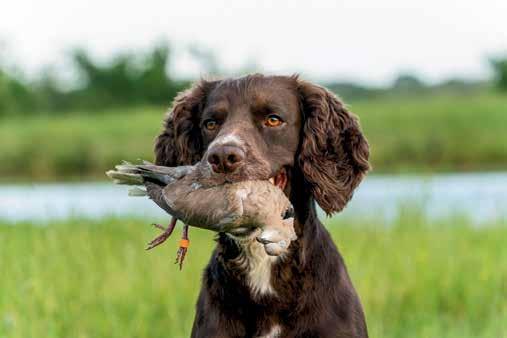
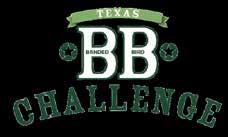
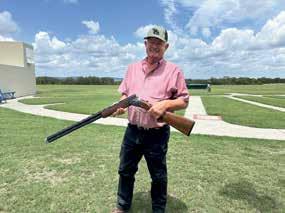
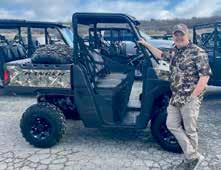

Advertising: Call (214) 361-2276 or email editor@lonestaroutdoornews.com to request a media kit.



AUGUST 21-22, 2025 || RIVIERA, TX & ONLINE
Whether it’s a for-profit business or a recreational opportunity for family, friends, and guests, the wildlife enterprise requires management. Facets that warrant attention include: habitat, wildlife, employees, infrastructure, financials, and guest expectations. Managing the diversity, quantity, and quality of wildlife will be left to the biologists. The focus of this new lectureship is managing the business aspects of a wildlife enterprise, because sooner or later, the money always matters.

For a detailed agenda and to register, please scan the QR code or visit: krirm.tamuk.edu/wildlifeenterprise
Instructors: Abe Woodard, Ph.D., Range & Wildlife Scientist; East Foundation • Justin Feild, Senior Wildlife Manager; Deseret Ranches • Roy Ludick, PH, Property Coordinator; Matador Resources Company • Tiffany Dowell Lashmet, J.D., Agricultural Law Specialist; Texas A&M AgriLife Extension




JULY 1
DALLAS SAFARI CLUB
Packing and Bag Stuffing Party
DSC Headquarters (972) 980-9800
biggame.org
JULY 12
MULE DEER FOUNDATION
Llano County Banquet
Inman’s BBQ, Llano (432) 290-4563 muledeer.org
JULY 17-19
DALLAS SAFARI CLUB
Summer Expo & Foundation Gala Gaylord Texan Resort, Grapevine (972) 980-9800 biggame.org
JULY 18-20

TEXAS HUNTERS & SPORTSMAN’S EXPO
McAllen Convention Center (956) 789-1456 texashunterassociation.com
JULY 26
ROCKY MOUNTAIN ELK FOUNDATION
Gulf Coast Banquet
Knights of Columbus Hall, Pearland (281) 245-9723 rmef.org

MULE DEER FOUNDATION
Culberson County Banquet
The Nido, Van Horn (432) 290-4563 muledeer.org
JULY 31
ROCKY MOUNTAIN ELK FOUNDATION
Central Texas Banquet
The Exchange Event Center McGregor (254) 707-0081 rmef.org

SITKA IN DALLAS

is looking for part time and full-time sales and marketing positions. Call (469) 445-1123
4,900-ACRE STONEWALL COUNTY HUNTING LEASE: Trophy whitetail deer, dove, hogs. On historic JD Patterson Ranch in northwest TX with 20+ years in TPWD management program. Also MLD participant. $12 per acre. Low fence. One-year provisional lease. Option to extend based on responsible stewardship of native wildlife/habitats.
AUGUST 2
ROCKY MOUNTAIN ELK FOUNDATION
North Texas Banquet
Embassy Suites, Grapevine (214) 693-8523 rmef.org
SAFARI CLUB INTERNATIONAL
Lubbock Chapter Banquet
Lubbock Memorial Civic Center lubbocksci.org
AUGUST 1-3
TEXAS TROPHY HUNTERS ASSOCIATION
Houston Extravaganza
NRG Center (210) 523-8500 ttha.com
AUGUST 7
EXOTIC WILDLIFE ASSOCIATION
Conservation Extravaganza
Hyatt Regency Hill Country San Antonio myewa.org
DUCKS UNLIMITED
Cibolo Creek Banquet
Mikulski Hall, Schertz (210) 862-9818 ducks.org
AUGUST 8-10
TEXAS TROPHY HUNTERS ASSOCIATION
Fort Worth Extravaganza Fort Worth Convention Center (210) 523-8500 ttha.com
TEXAS GUN SHOWS
Legends Event Center Bryan (210) 844-9599 gunshowstx.com


Continued from page 4
roller-chopped brush, with nearby brush cover, and brush mottes as well. Typically, you want to have these strips done before they hatch, but the timely rainfall these past couple of weeks has made it tough to get it done without tearing anything up.” Poults beat the odds just by hatching. The majority of turkey nests succumb to predation, weather or hens abandoning them. It will take roughly 28 days for eggs to hatch, and even at that point their chances of survival for the first three weeks are slim. Harsh weather conditions
can have a drastic impact on a poult’s life. It is harder for them to regulate their body temperature, making them susceptible to overheating or hypothermia. By the end of the third week of life, the poults’ chance of life increases greatly. Their feathers are starting to come in, which means they can fly short distances, and can start to roost off the ground. Their diet starts to mix more with plants like an adult bird, and by the sixth week of life they aren’t considered poults anymore — but juveniles.


RENO EQUIPMENT/ RIO GRANDE PIPE
Our companies sell structural pipe in several sizes, from small pipe for gates, to standard sizes for fencing, on up to the larger sizes for H-braces, barn legs and even culverts. We stock pipe sizes from 1” to 20”, we even have heavy weight and thick wall pipe in several sizes for heavy duty projects. We also sell an assortment of other equipment, currently we have some surplus tanks (8400gal, steel, 12’w x 7’h), some tinhorn/culvert material (from 4’dia x 6’-10’L to 16’dia x 10’-20’L), 18’ & 20’ gooseneck tandem single trailers, and some cattle guards. Contact Josh Brown at (505) 366-3428, or Cody Hudson at (575) 441-1186.
MAMMOTH ALASKA BROWN BEAR Live Aboard Boat Hunts Alaskan Safari and Trading Company (907) 491-1025
ARCHERY CLUB Network of Archery Ranges For One Membership! TEXASARCHERY.INFO
AUSTRALIAN WATER BUFFALO HUNTS Come see us at the DSC Summer Expo July 17-19 Grapevine, Texas Graham Williams BUFFALO577.COM BUFFALO577@HOTMAIL.COM
HUNTING. EXOTICS, WHITETAIL. BEST PRICES. NO MIDDLEMAN. LETS HAVE FUN. (830) 928-0370
HUNTING RANCH FOR SALE With Unique Underground Lodge & Bunker Thomas A.C. Davis TDavis@TexasRanchSalesLLC.com (832) 977-0071

electric
location on dead-end county road. 1 hour NE of Melissa, McKinney, 1.5hr NE of DFW. Invest in your hunting future today! (903) 517-5889
AFRICA Hunting: All Inclusive - No surprises Includes: Animals, daily rates, taxidermy, shipping home. To find out more: LONESTARAFRICA.COM
ADVERTISE YOUR HUNTING LEASE HERE Only $1 per word. Email editor@lonestaroutdoornews.com or call (214) 361-2276
PROFESSIONAL BOOKKEEPING SERVICES From a name, you know and trust Contact Lea Marsh Accounts payable/receivable/payroll Small business,
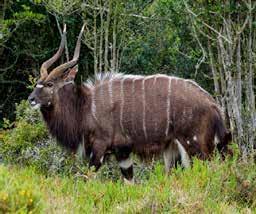
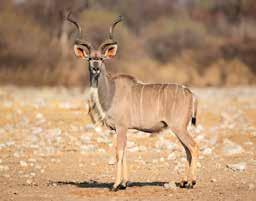
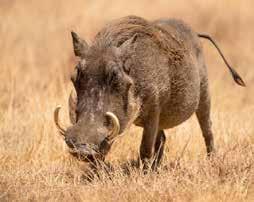
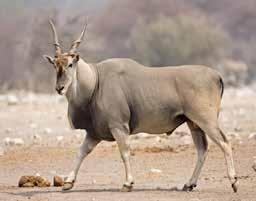
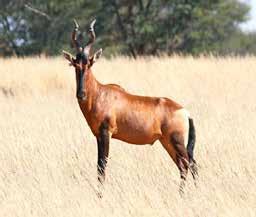
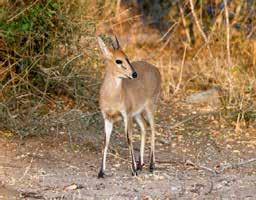


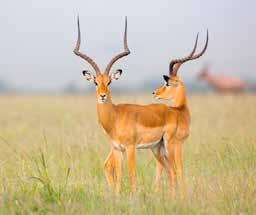

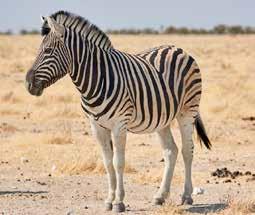

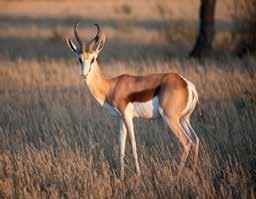

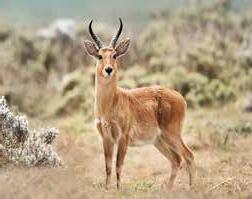
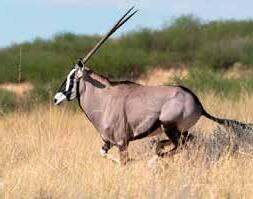
Based in Texas and in Africa, LONE STAR AFRICA offers traveling hunters a unique service. With partners in Africa, yet based in Texas, we bring you Africa with absolute peace of mind. Based on our media knowledge, understanding of every element of the safari, it is time to take care of hunters, from A-Z.
• A unique ‘End-to-End’ service, where traveling is about enjoying the safari and us taking care of every detail. We take care of:
• Booking flights through an agent who specialises in this.
• Arranging the Joburg airport meet and greet, gun permits if you need, overnight accommodation with Afton Safari Lodge
• Transfers to and from the game lodge.
• On the ground, 24/7 contact, while in Africa, giving you ‘in-country’ peace of mind.
• Offering the most affordable ALL-IN safari pricing using trusted and qualified outfitters.
• Ensuring the taxidermy & trophy shipping - of your trophies is efficient, superior quality and the most affordable solution. From the salt on the game farm to your trophy room, finished and processed, this turnkey A-Z, one point of contact service; is what we call taking care ‘after the hunt.’
